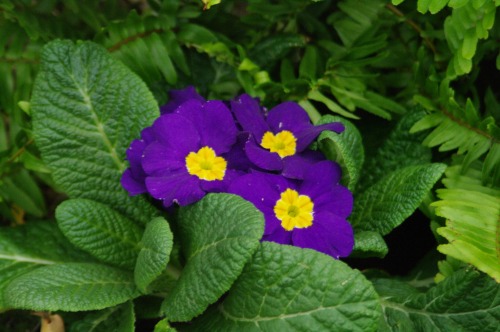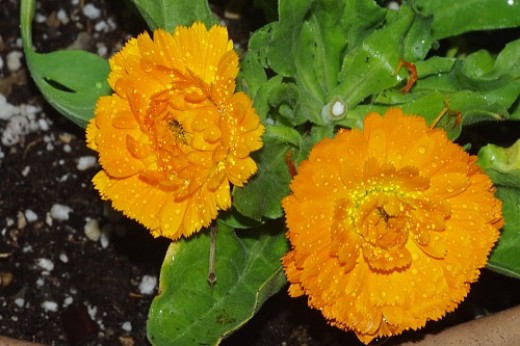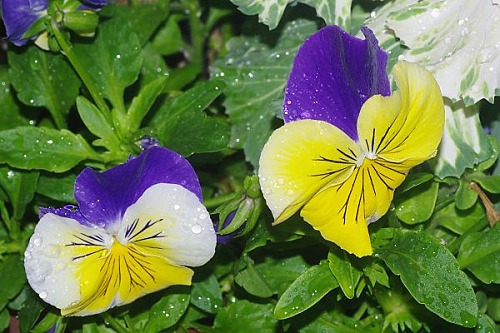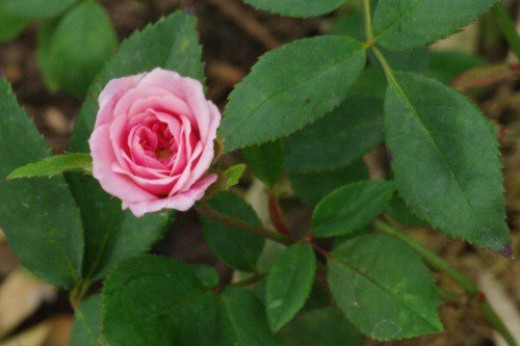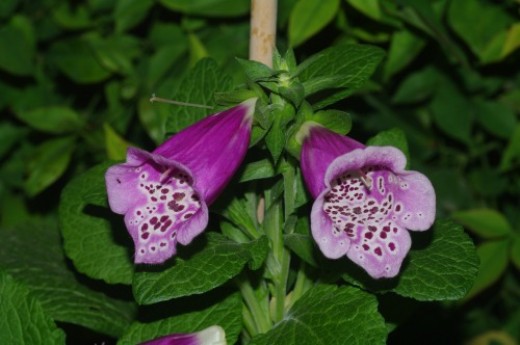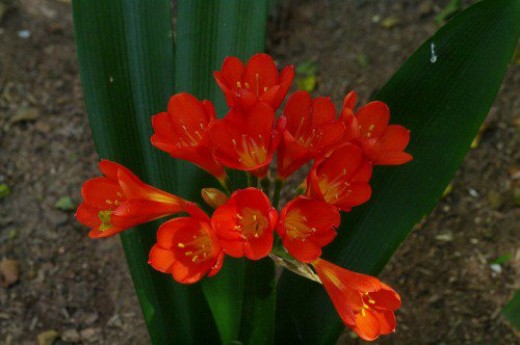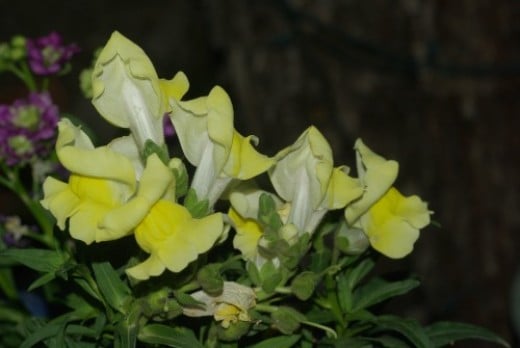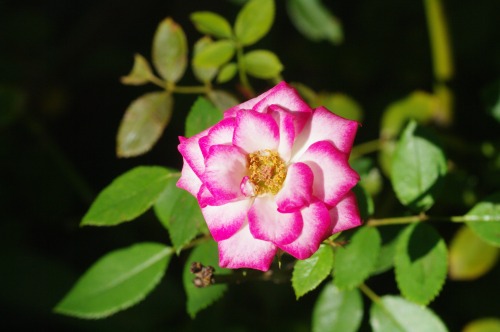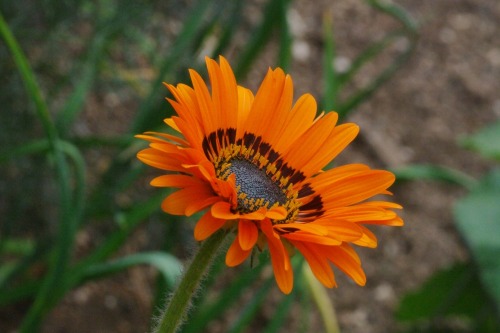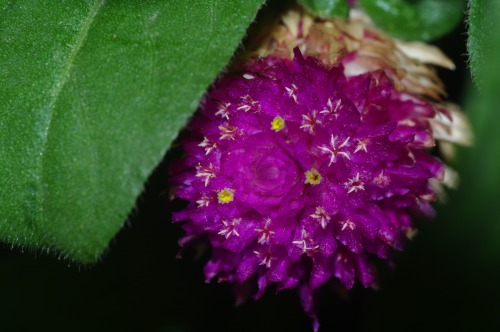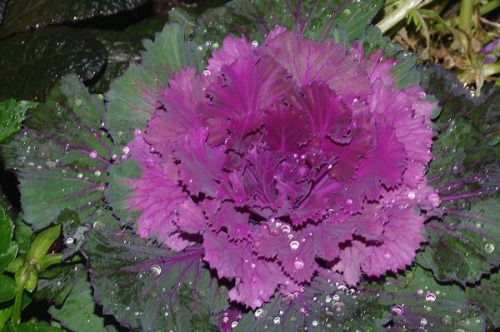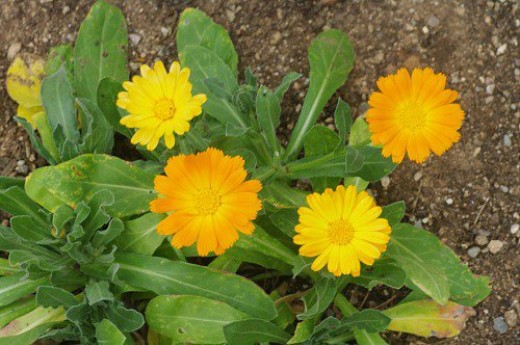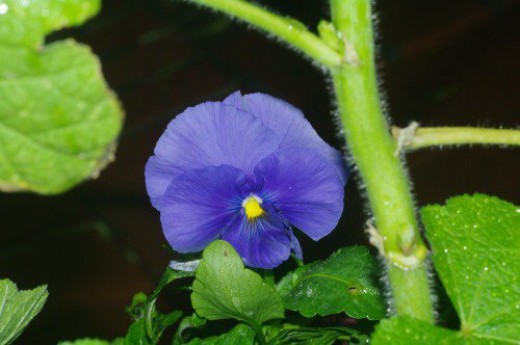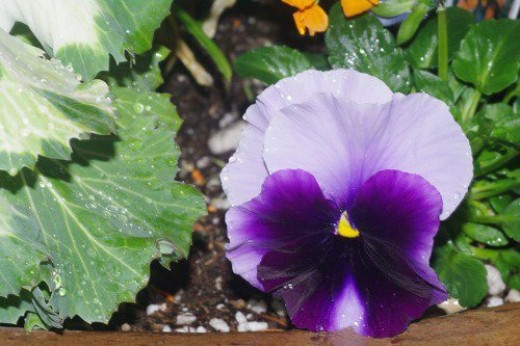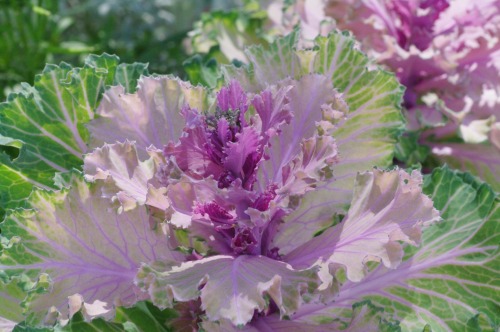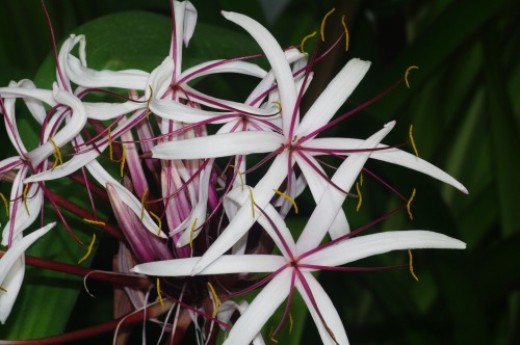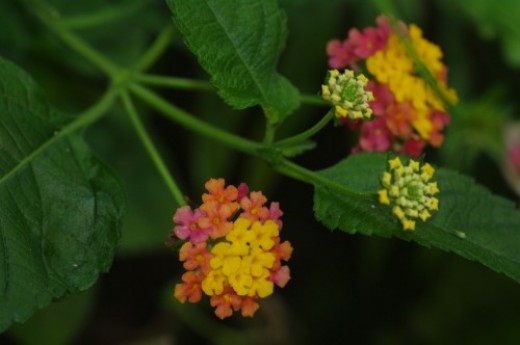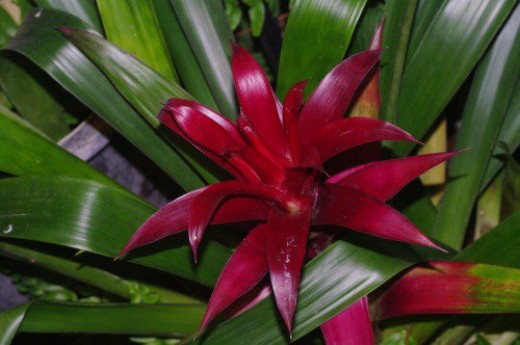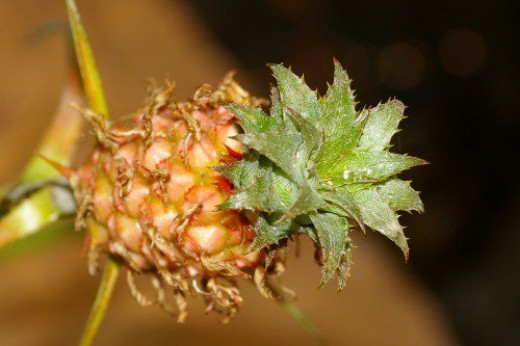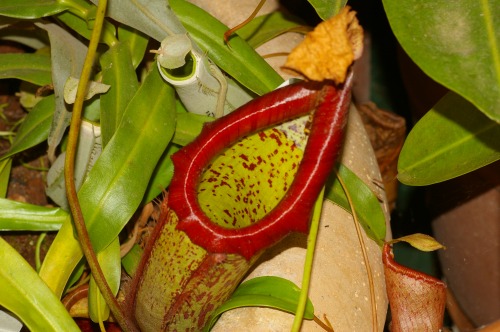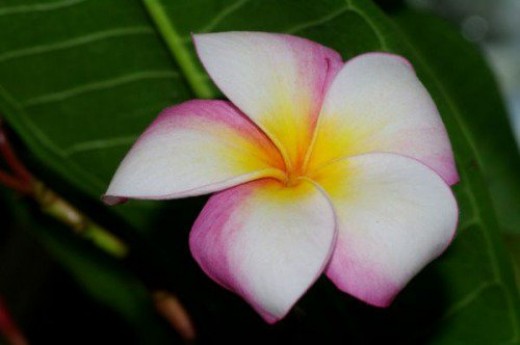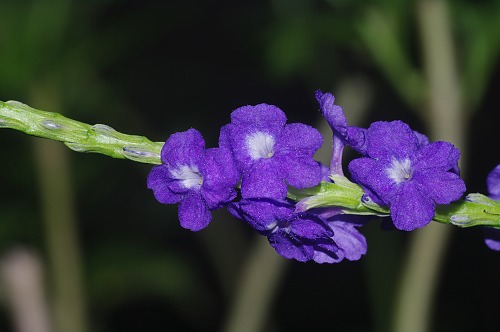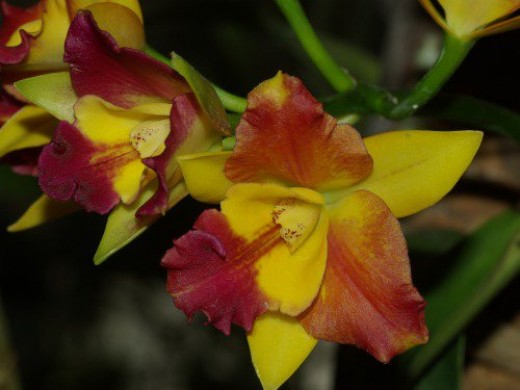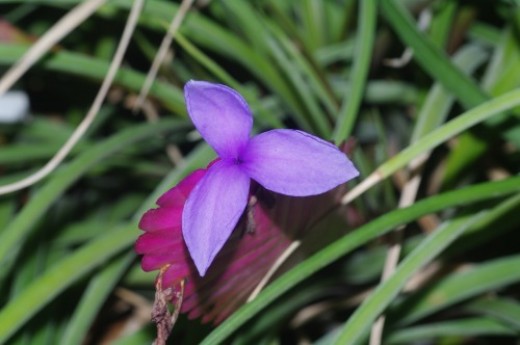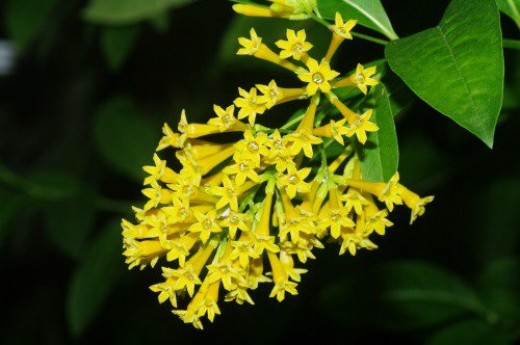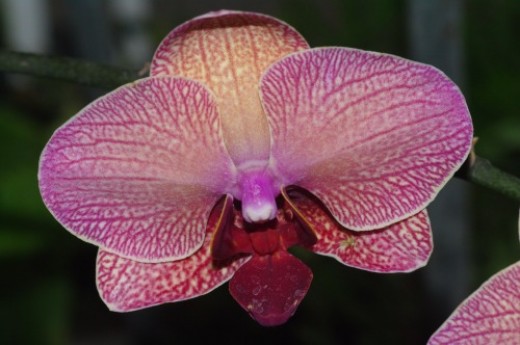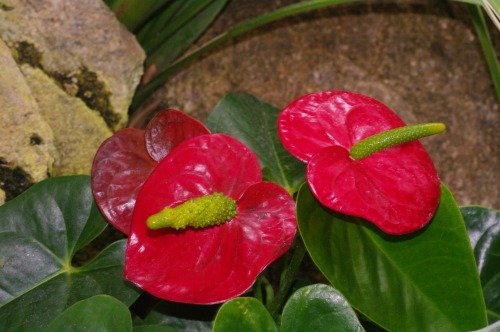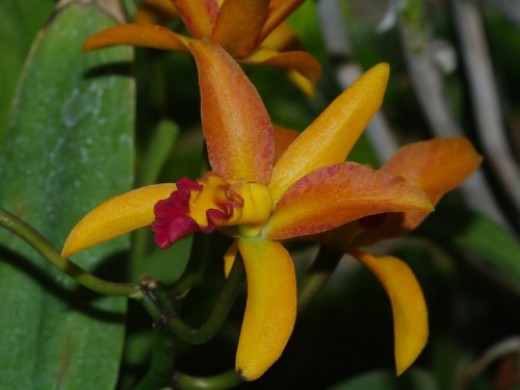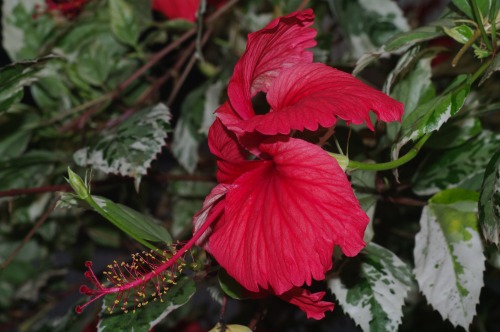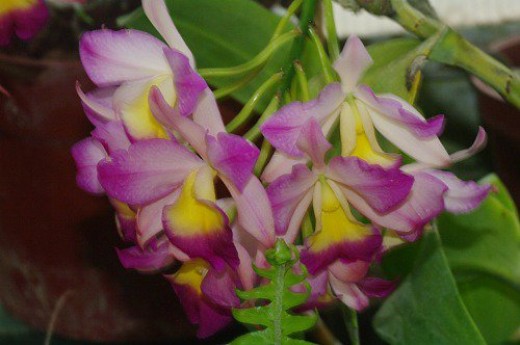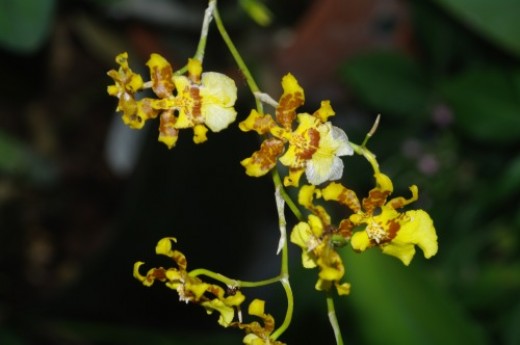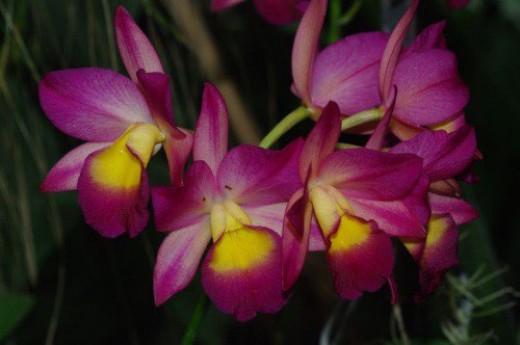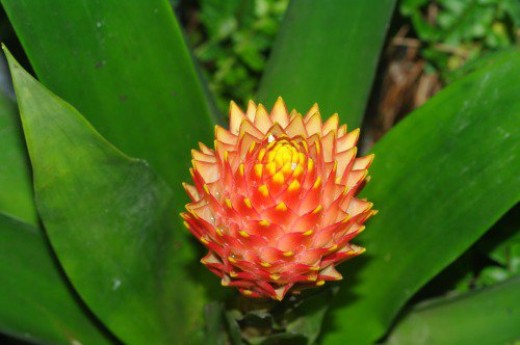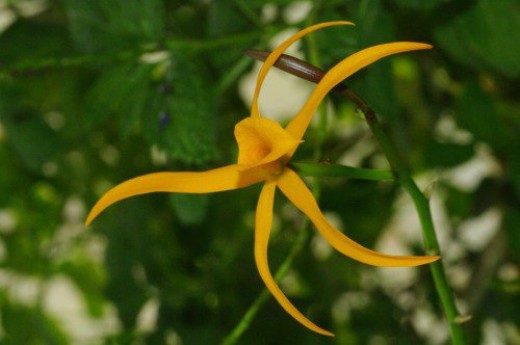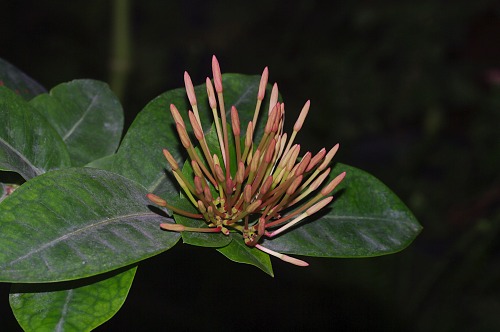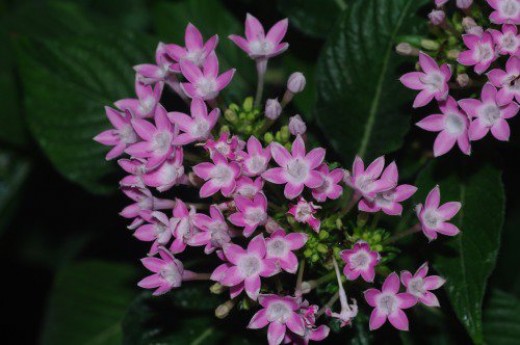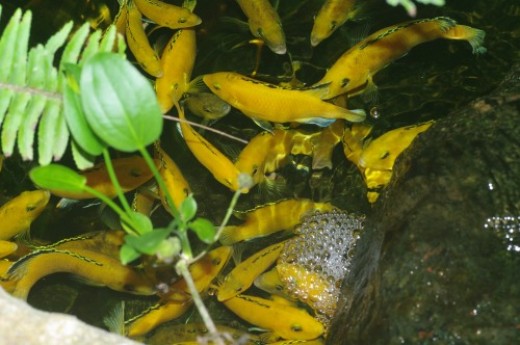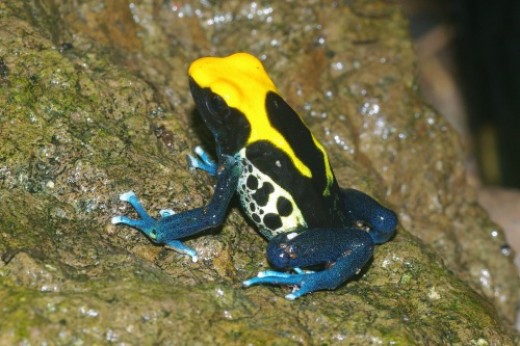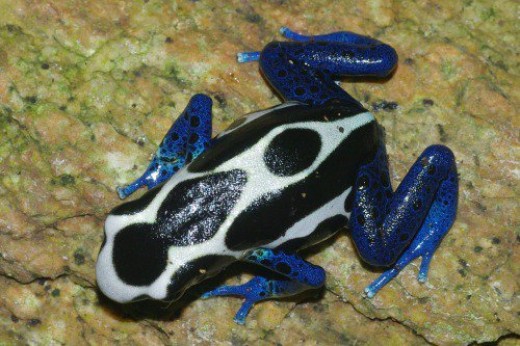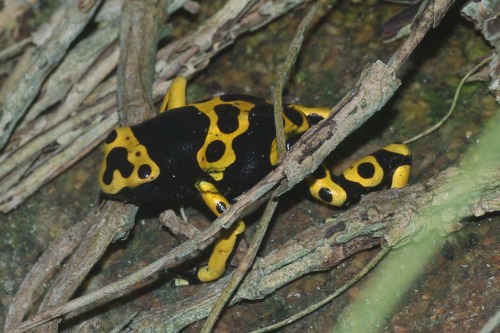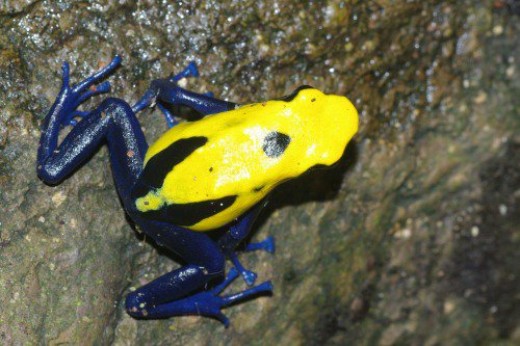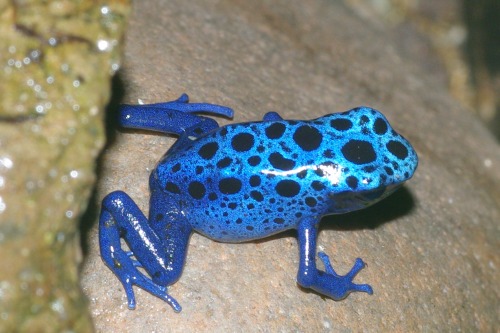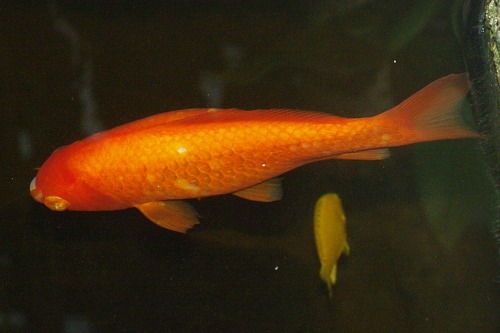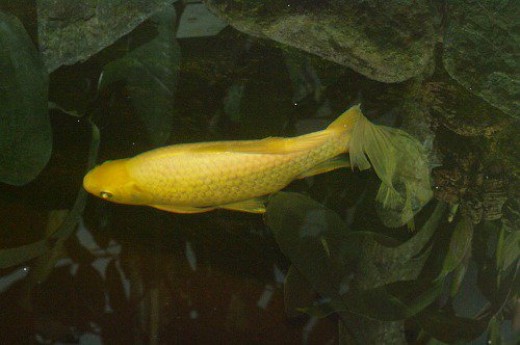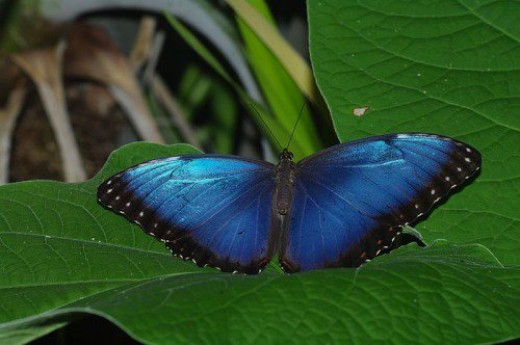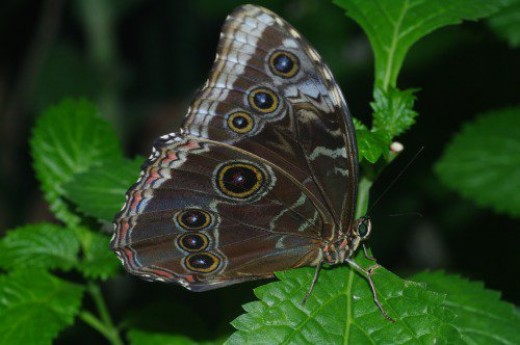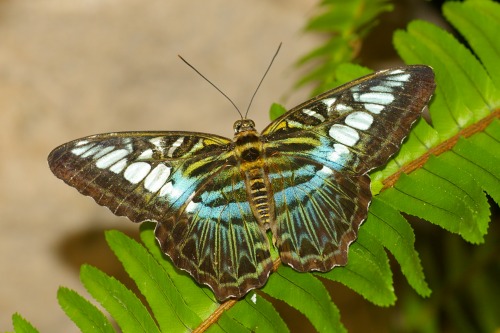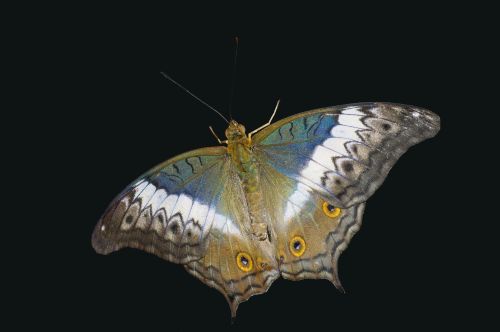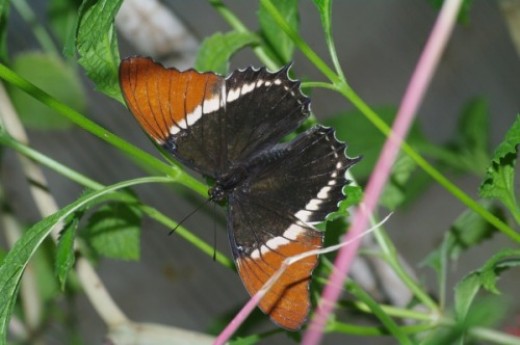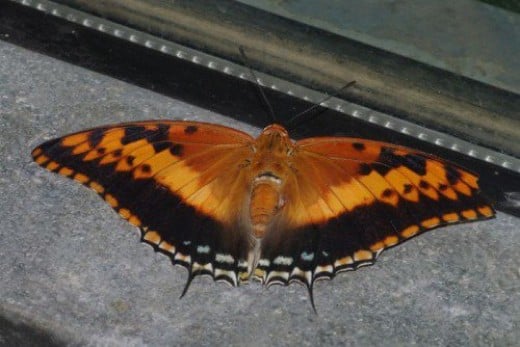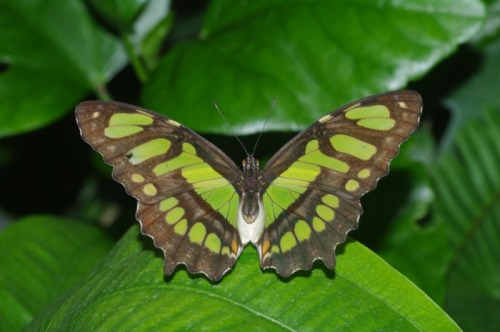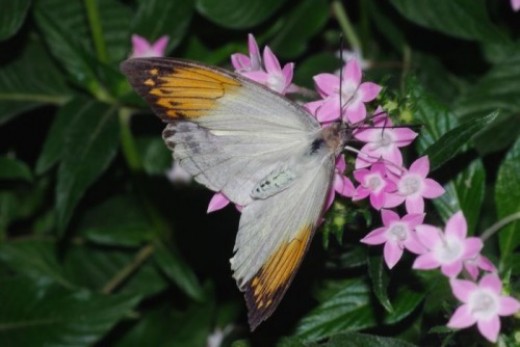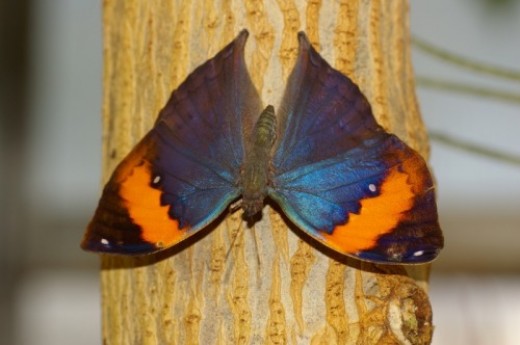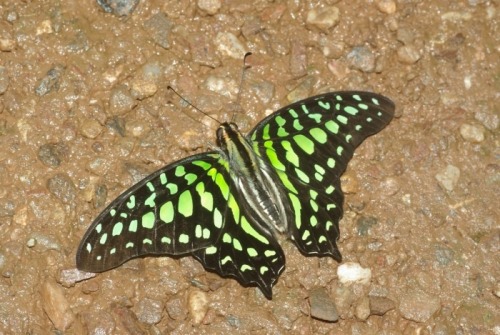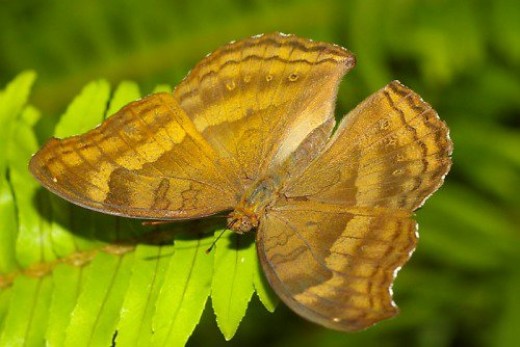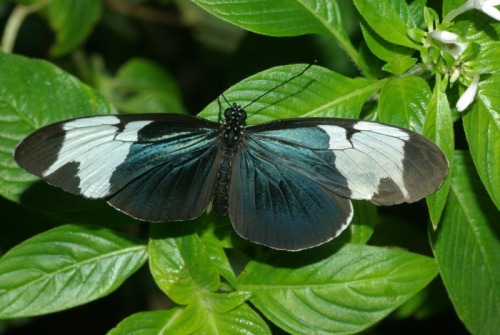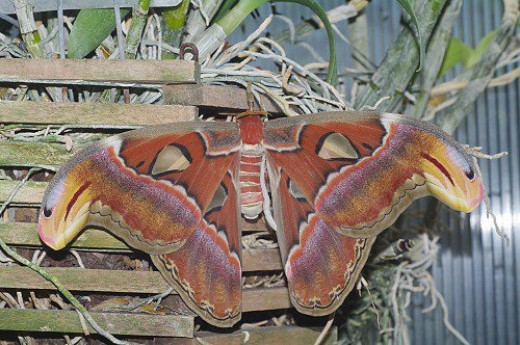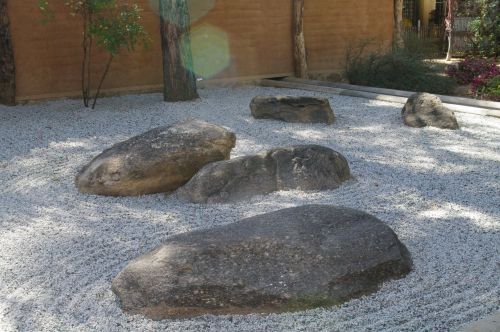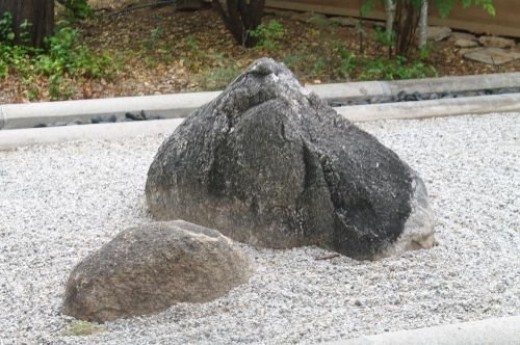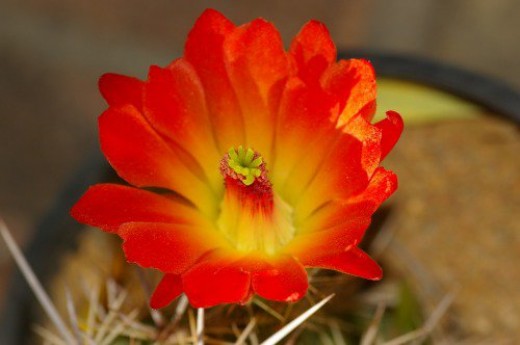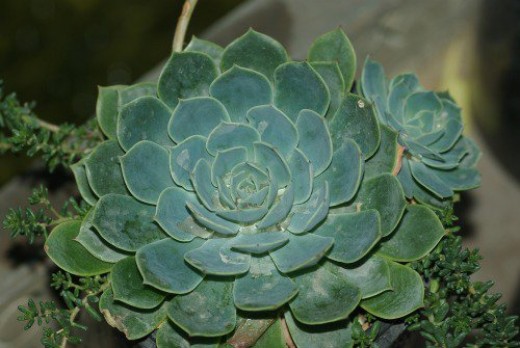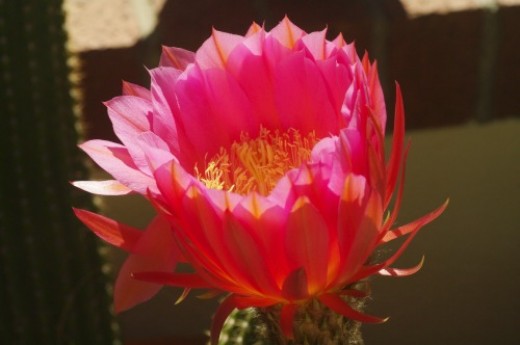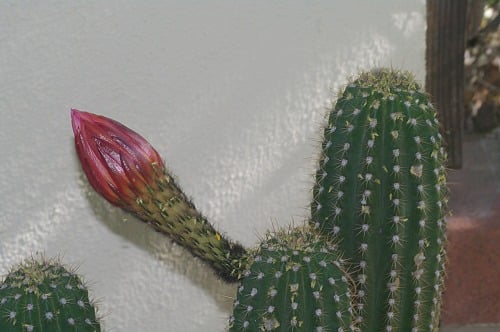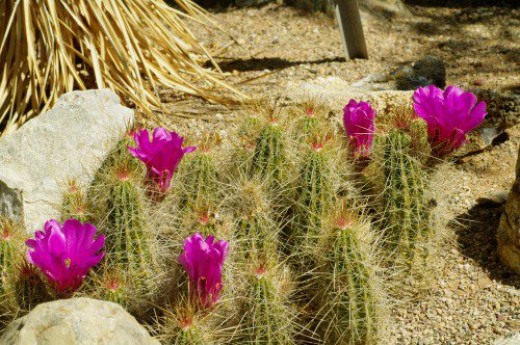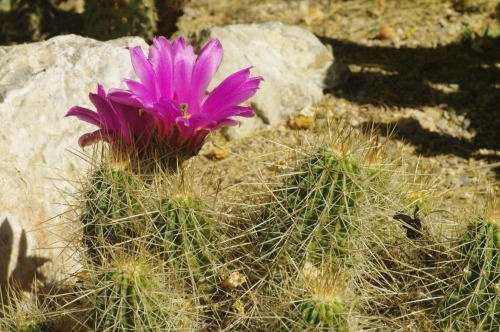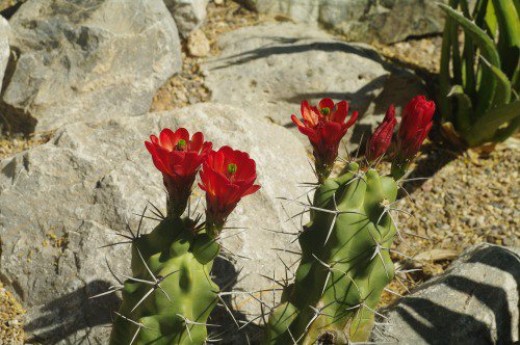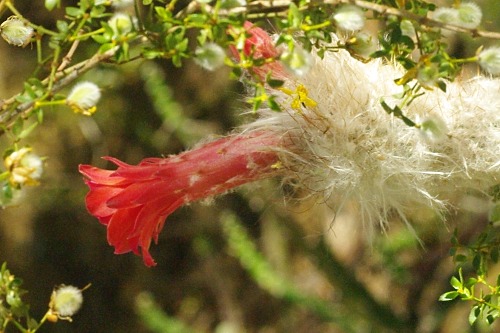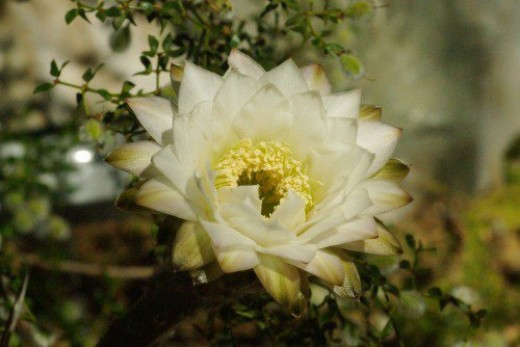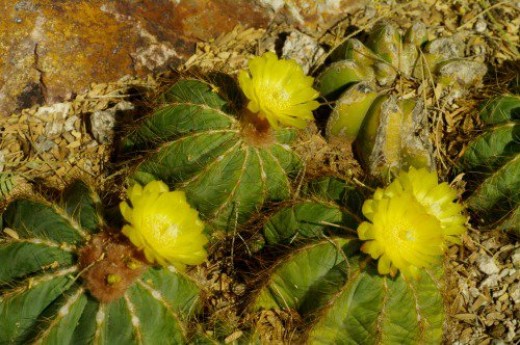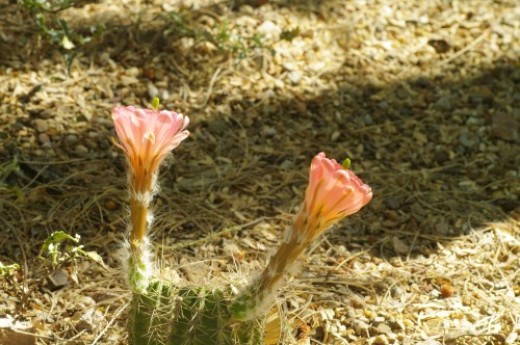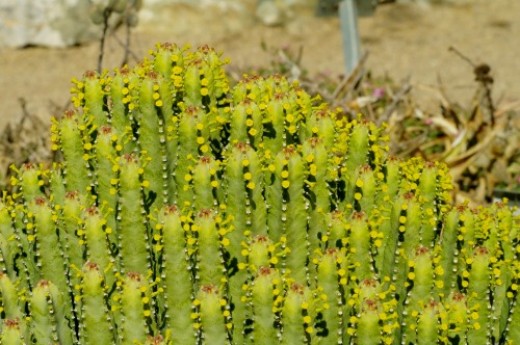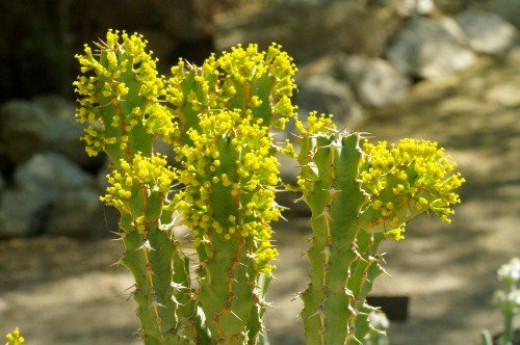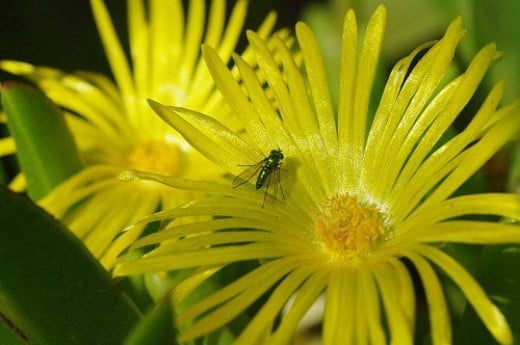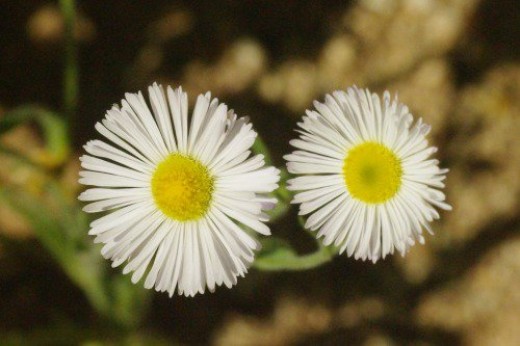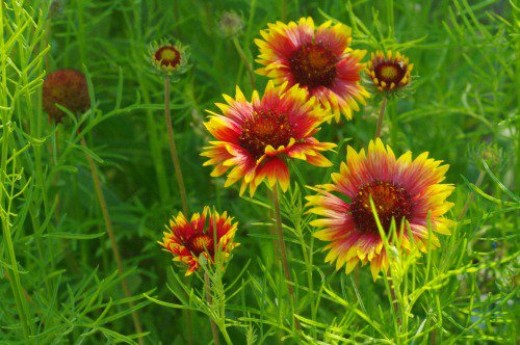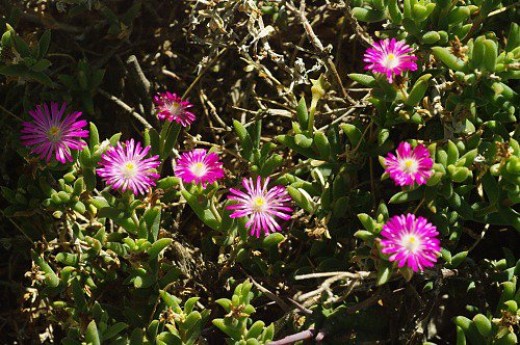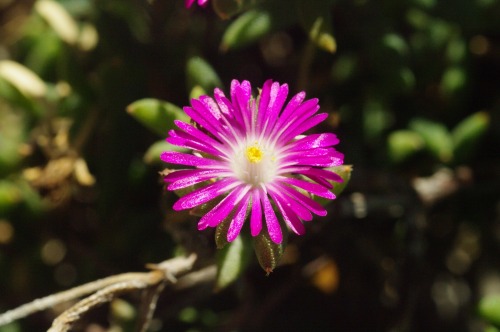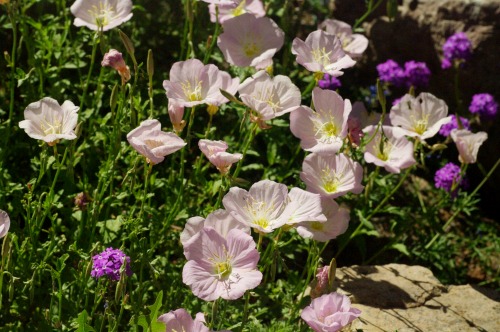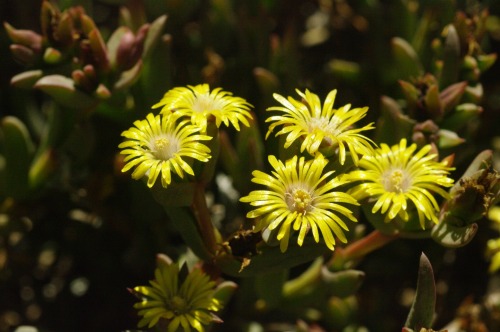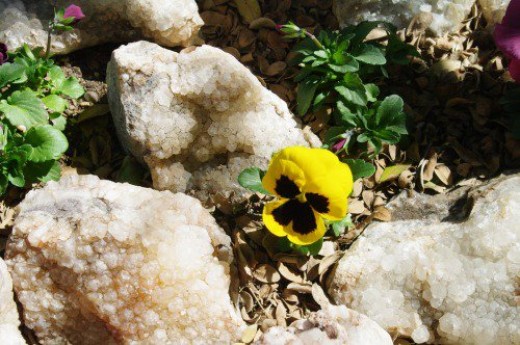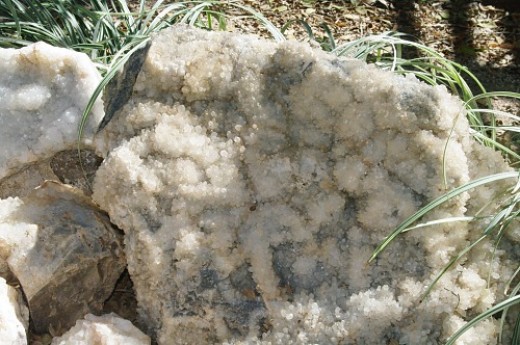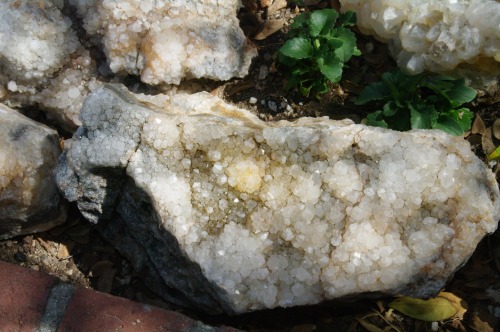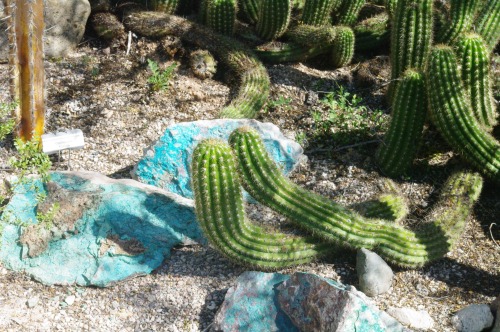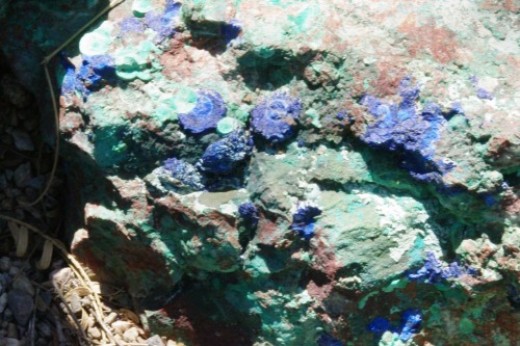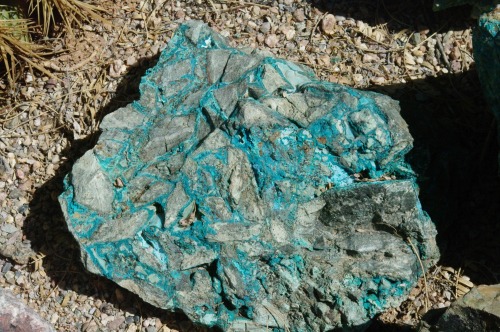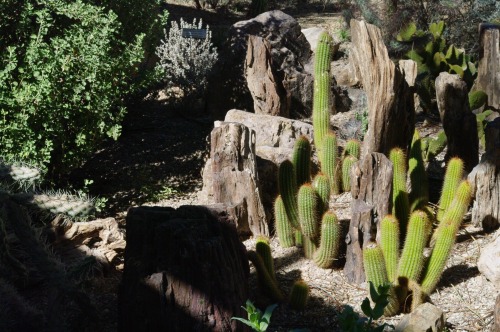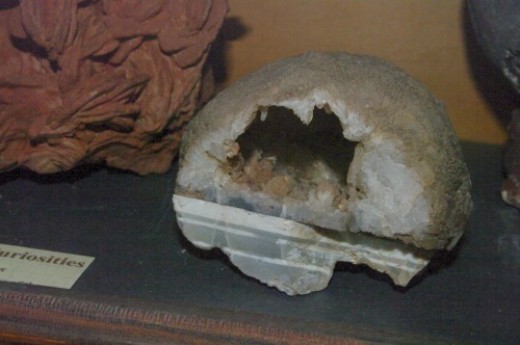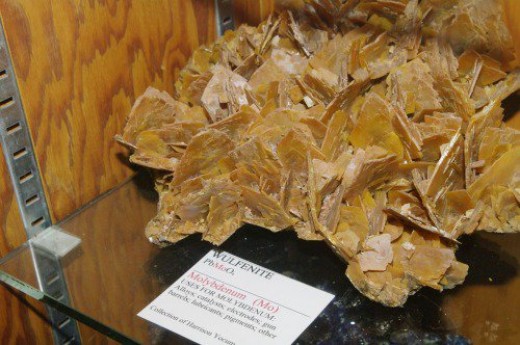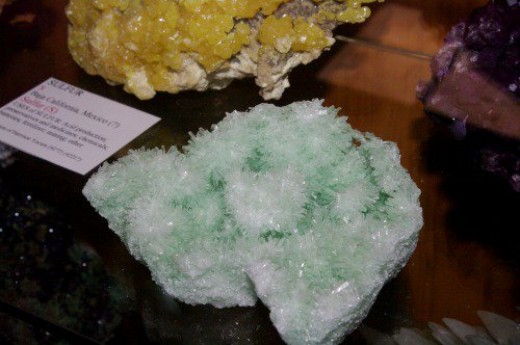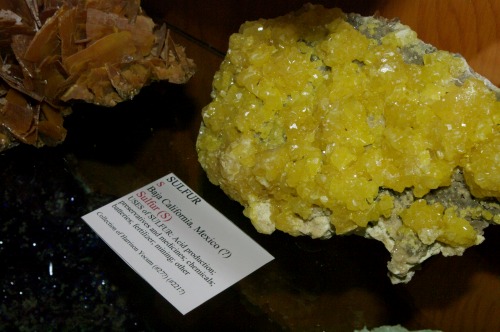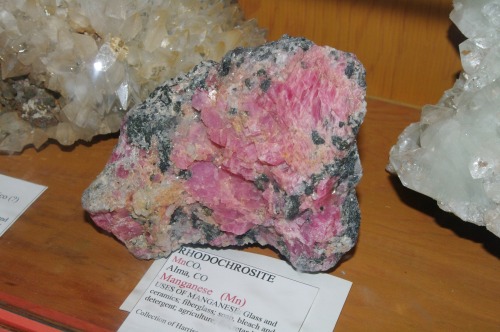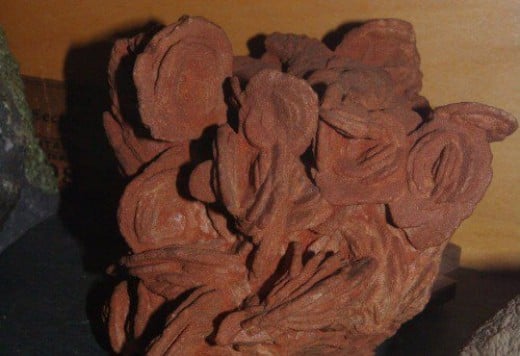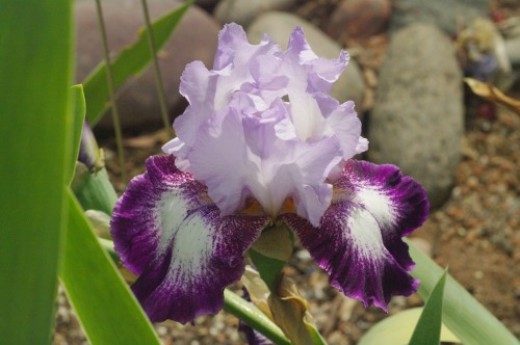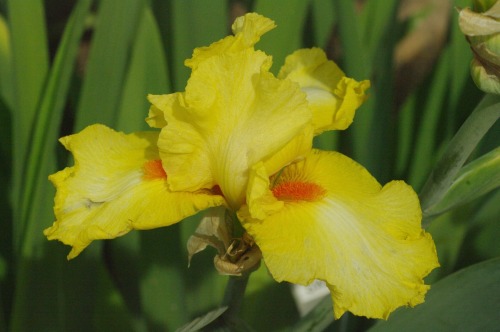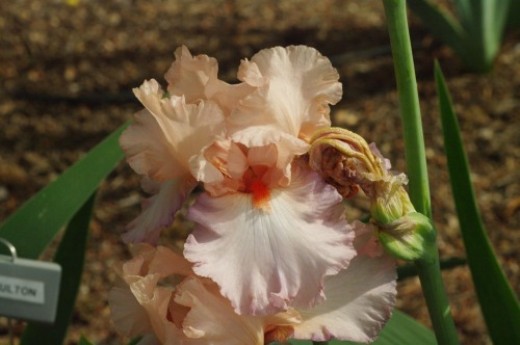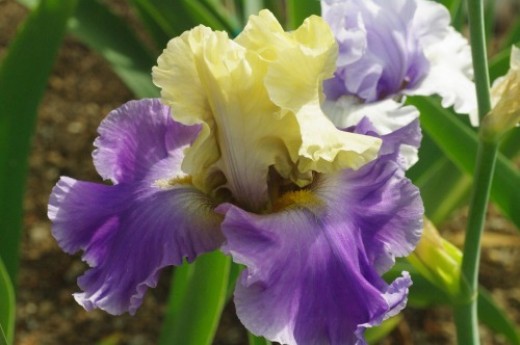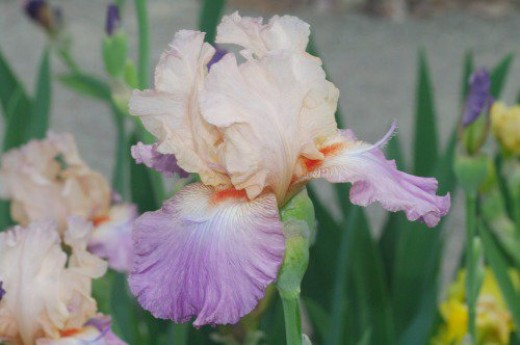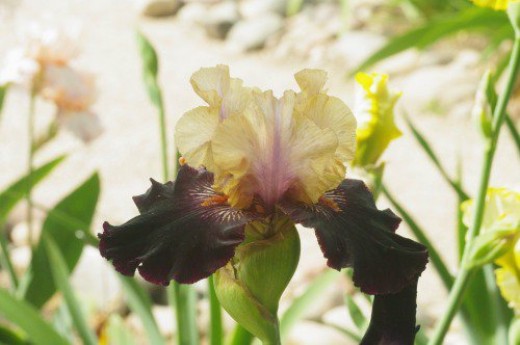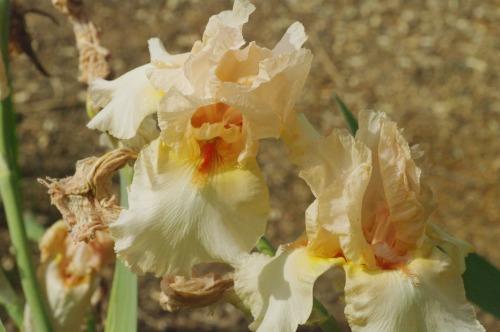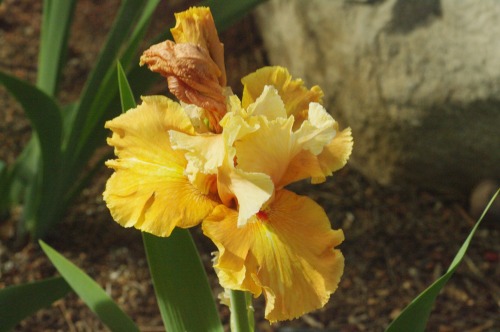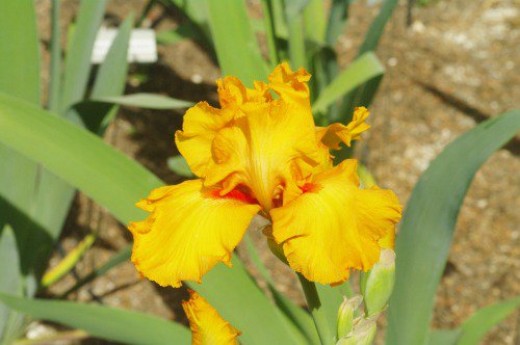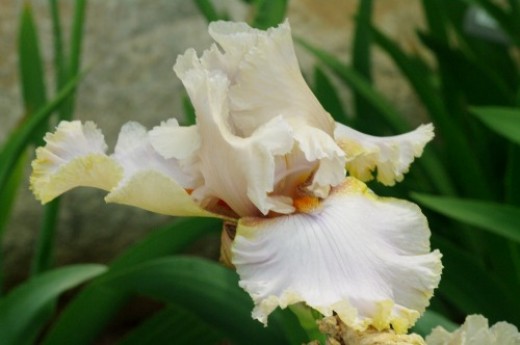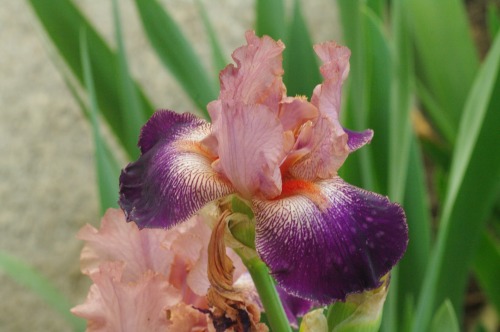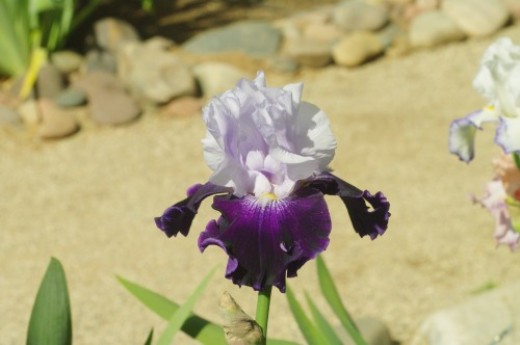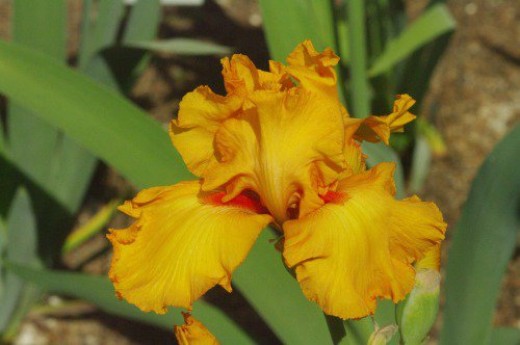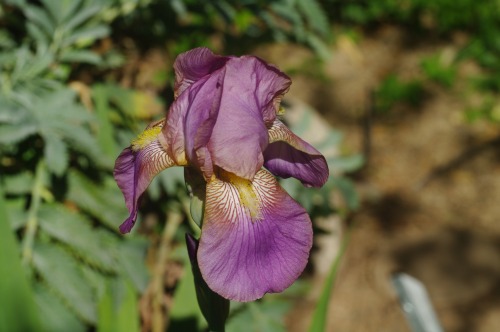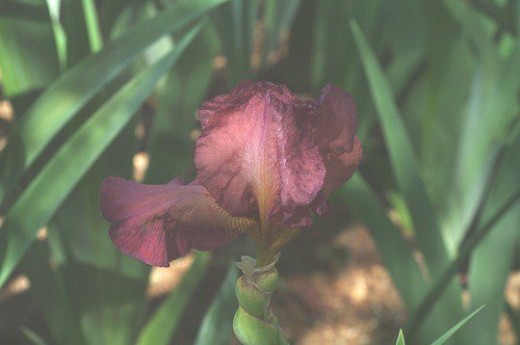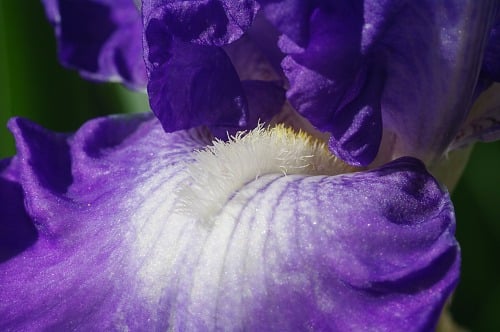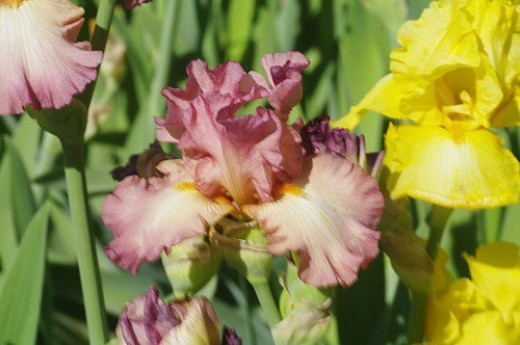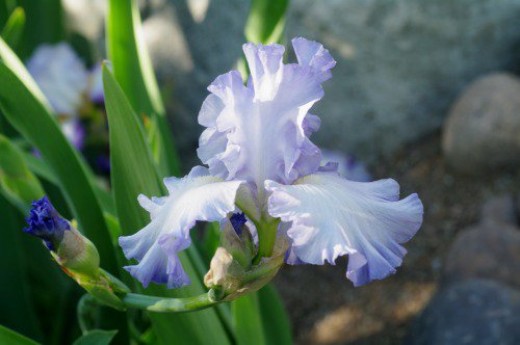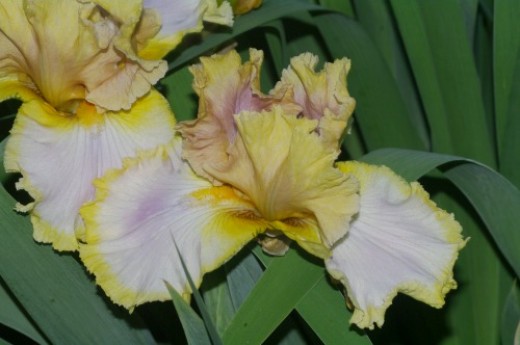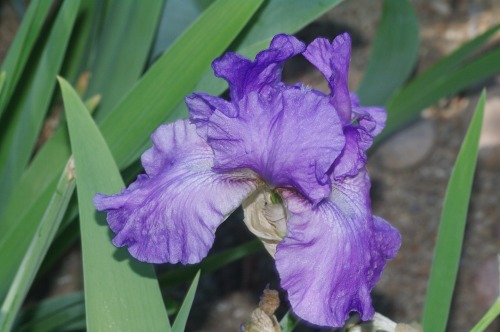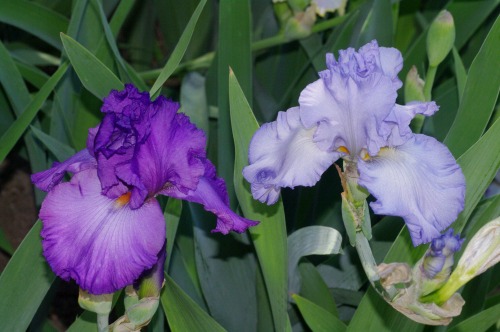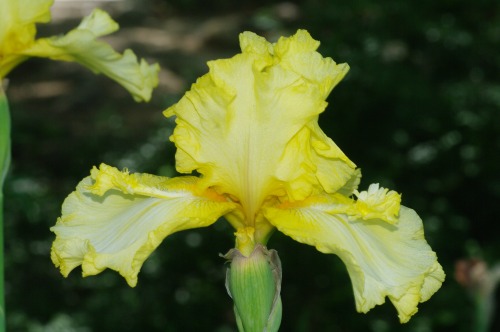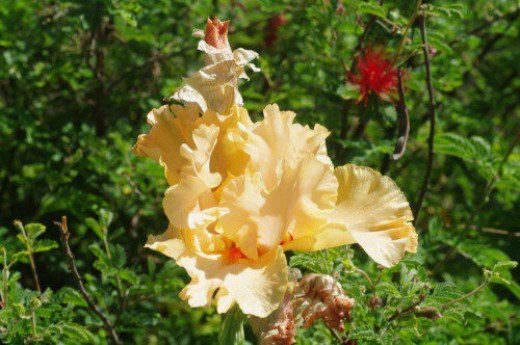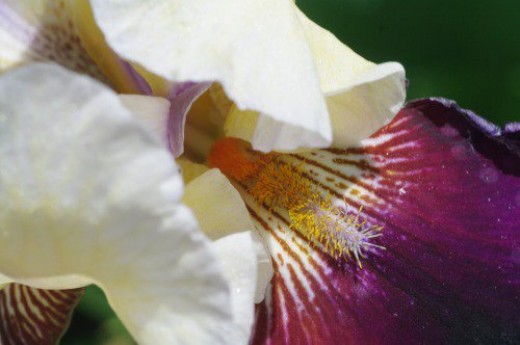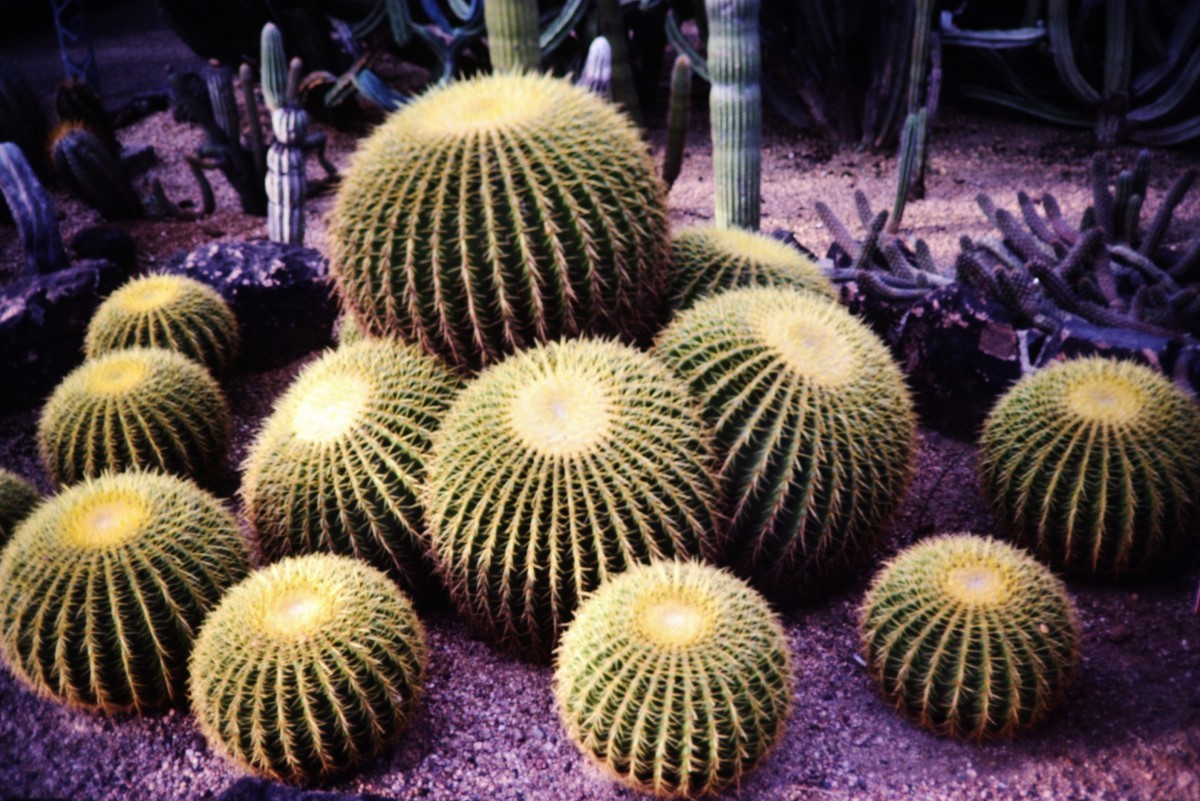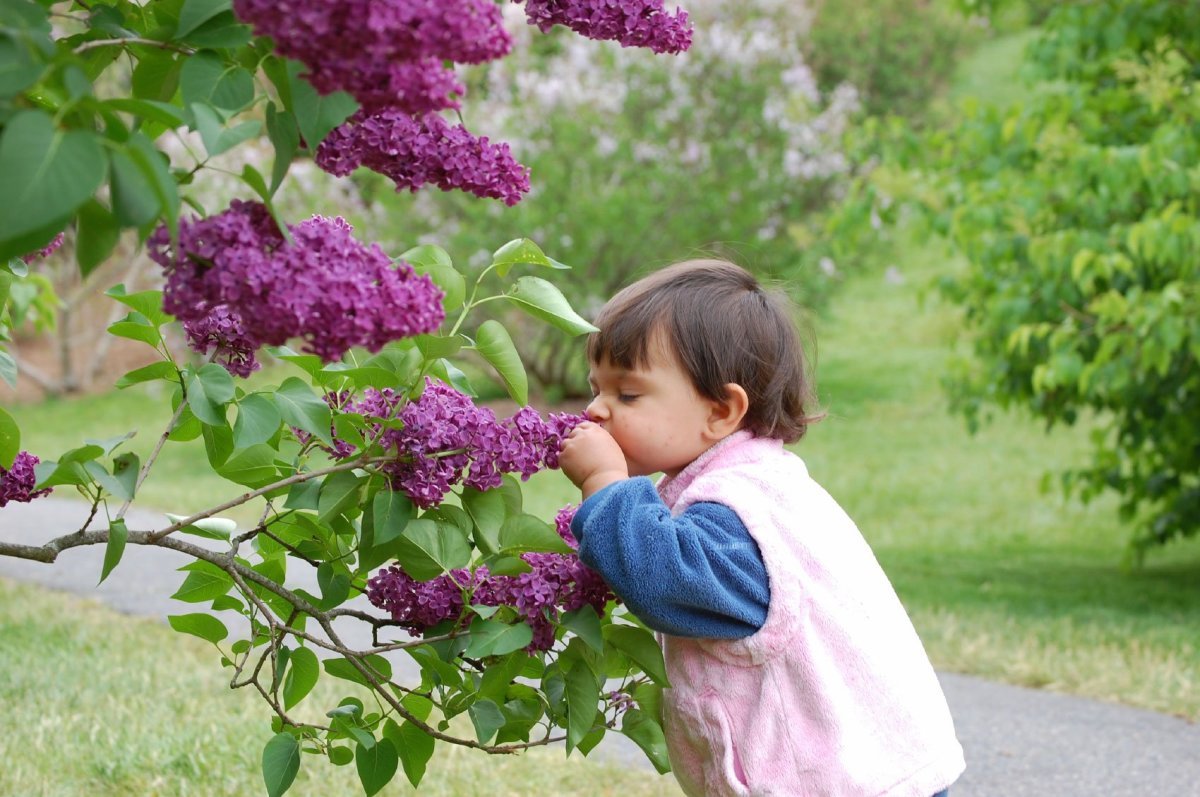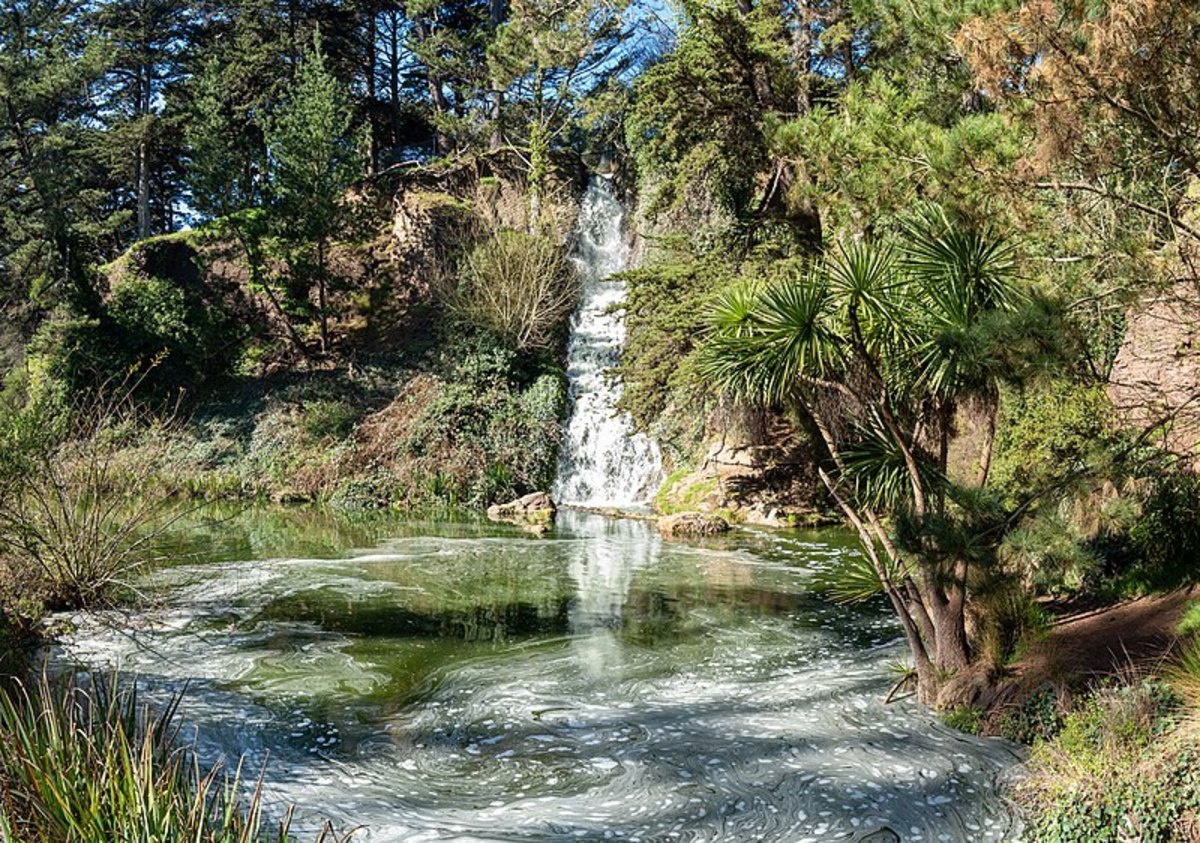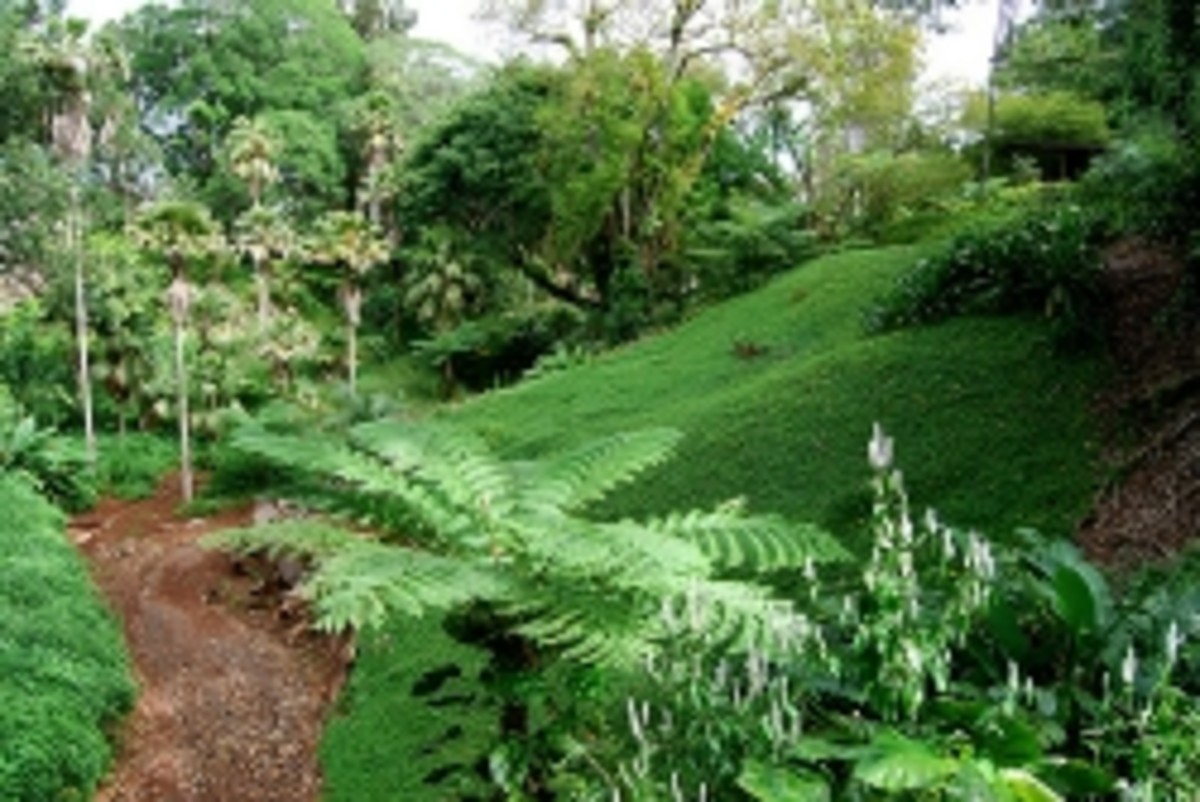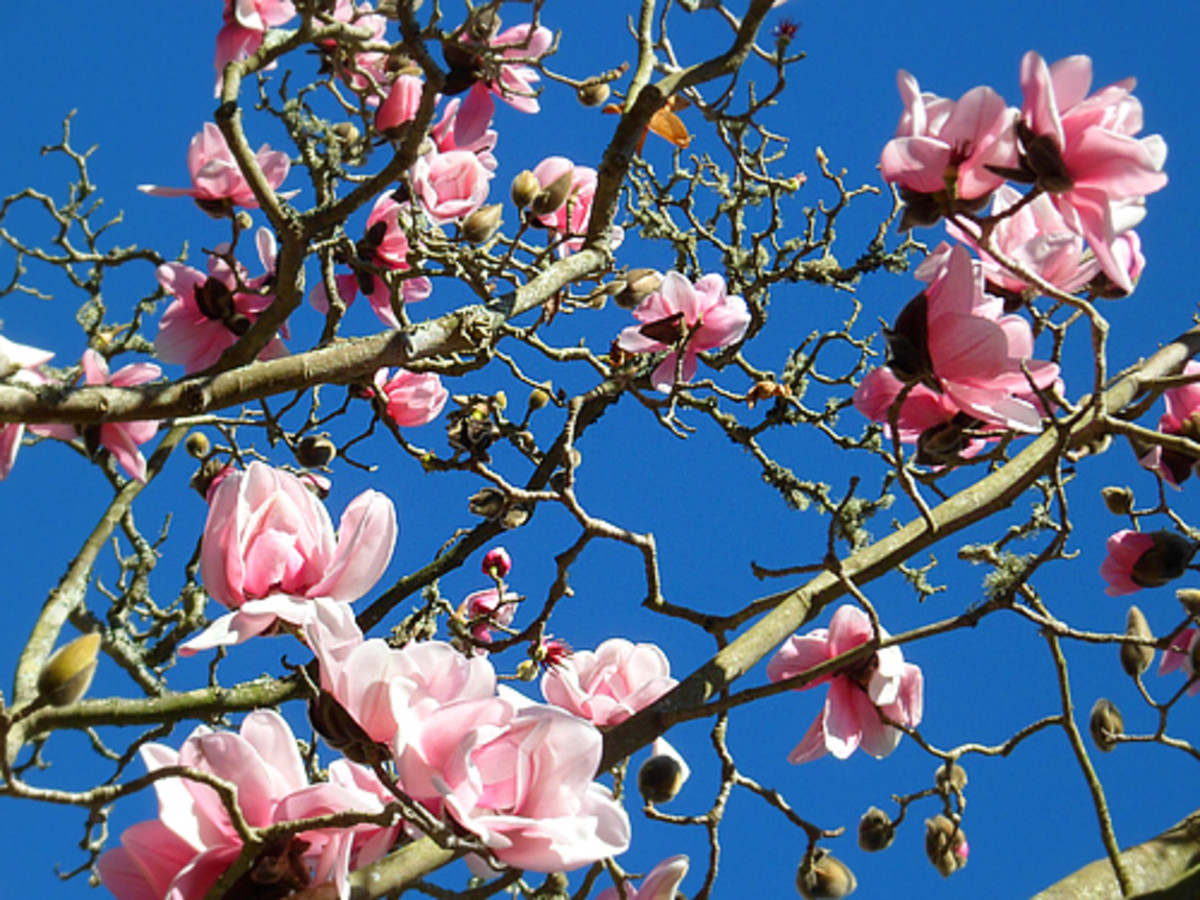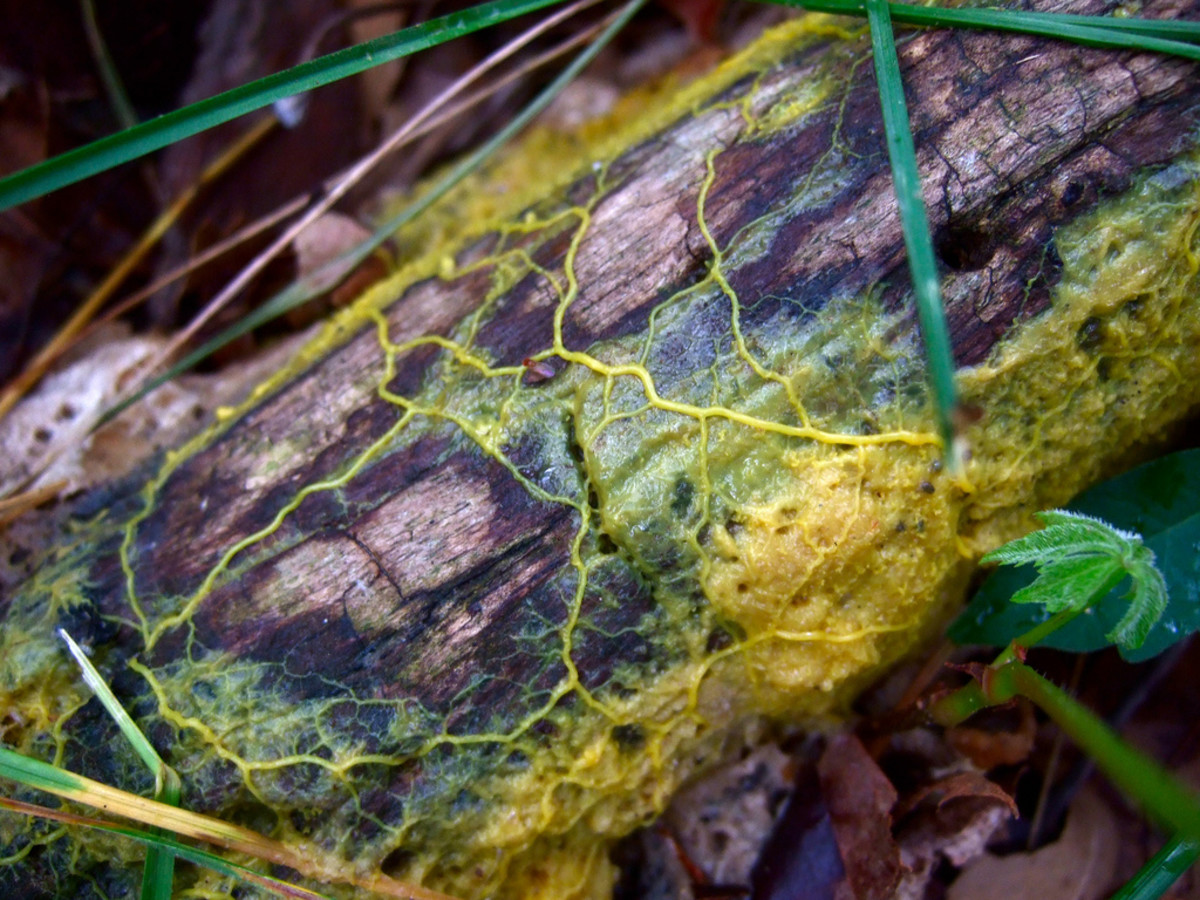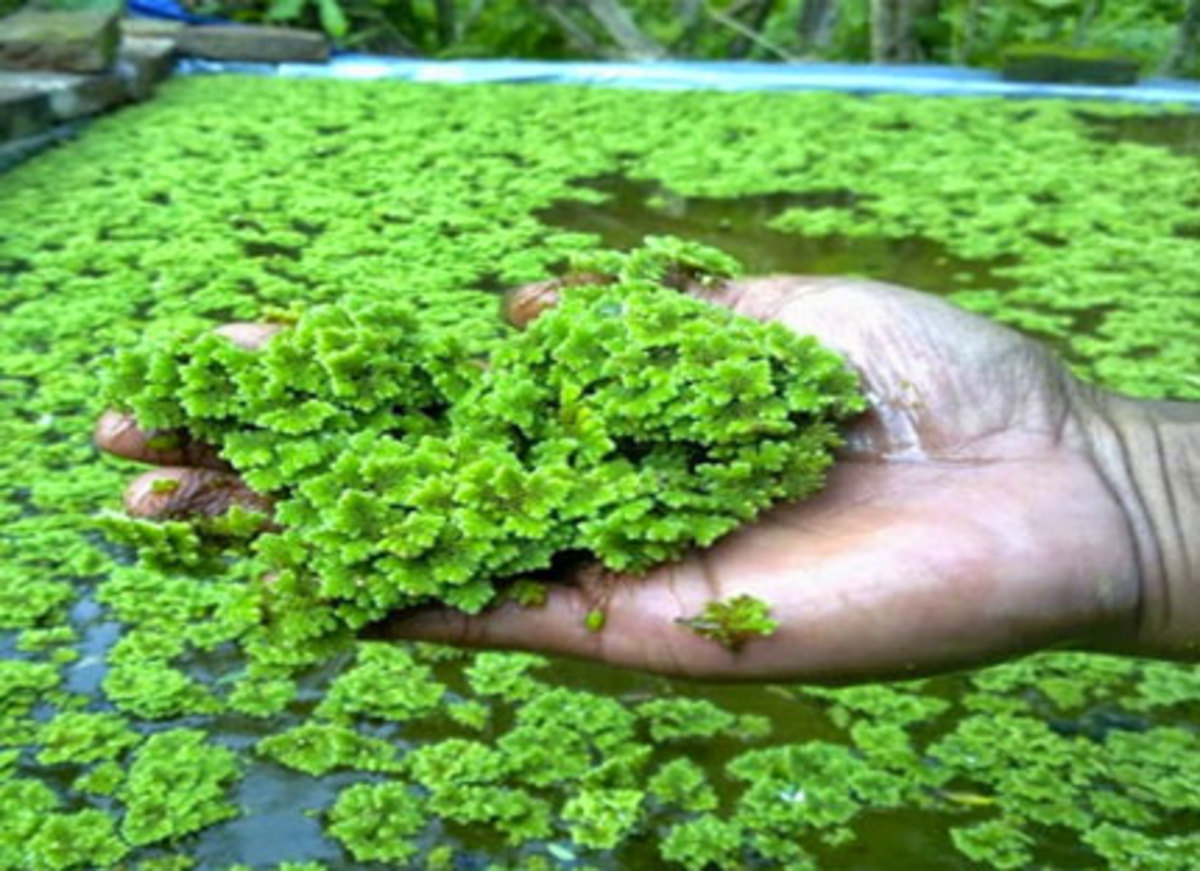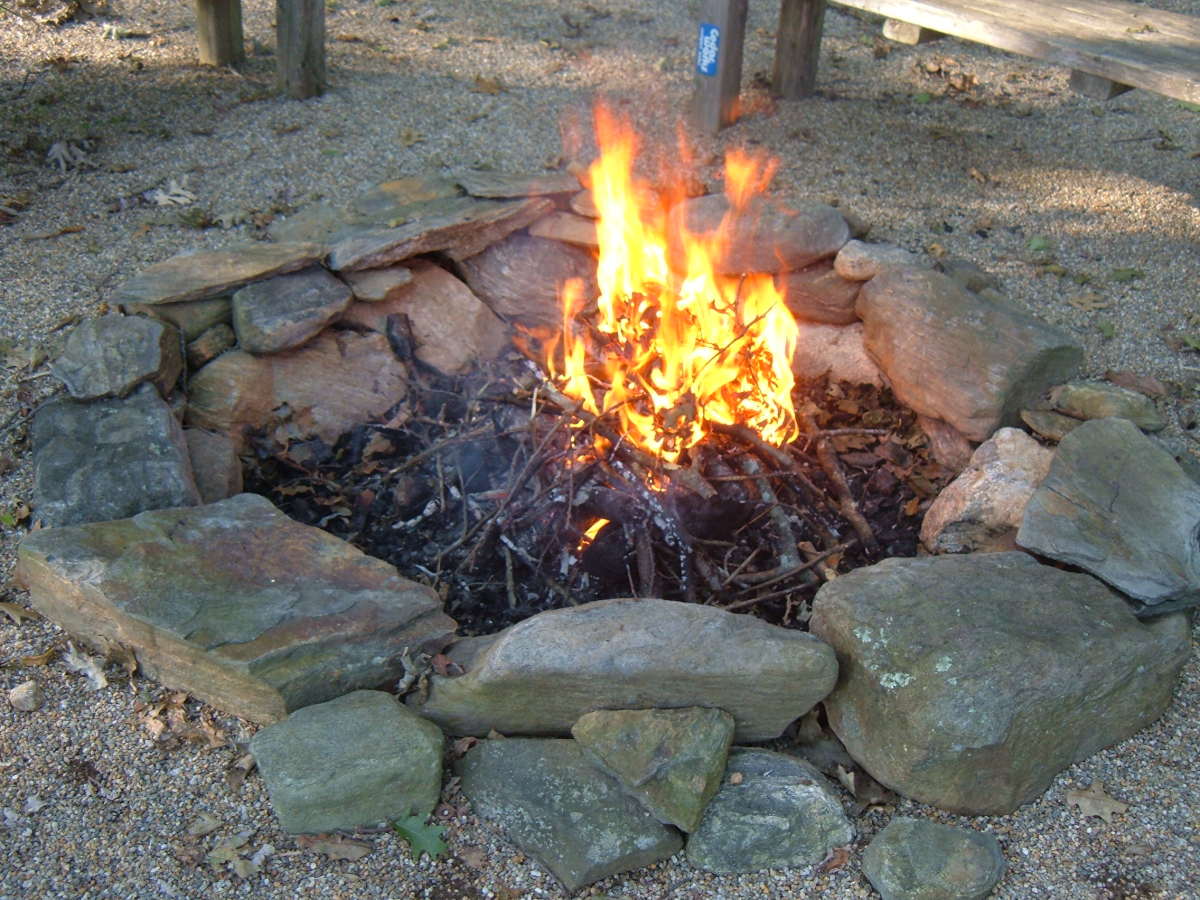Tucson Botanical Gardens - a Tour
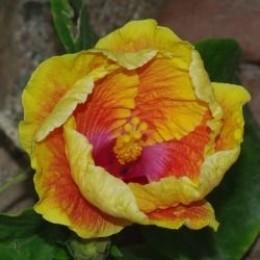
A Place of Beauty
Tucson has two major botanical gardens. This is the other one (I already talked about Tohono Chul Park). Founded by Harrison Yocum many years ago, it has grown to be a very interesting place.
Among the features are the tropical greenhouse, full of tropical plants, particularly orchids, a zen garden, a whimsical train layout, educational exhibits, a collection of irises managed by a local iris society, garden plants, xeriscaped gardens, lots of cactus and succulents, a demonstration garden of heirloom seeds from the area, culinary herbs growing, lots of nice shade, and...
an exhibit of tropical butterflies that runs from October through April. This exhibit has a new feature: poison dart frogs, five brilliantly colored variations. Little tiny frogs, they like to hide, but if you are diligent and patient, you can catch them out in the open.
The butterfly exhibit is my favorite attraction.
All photos mine, taken at Tucson Botanical Gardens. This one is a Hibiscus flower growing in the tropical greenhouse. The variety is Georgia's Pearl, and the flowers are HUGE!
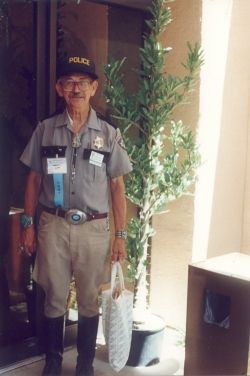
History
The Tucson Botanical Gardens was originally founded by Harrison Yocum, who gathered a few like-minded folks to put it together. Originally, it was located around his house, where he had gathered mineral specimens from all over Arizona and parts of New Mexico. With these he built three tall mountains of these interesting rocks, by piling them one on top of another, and planted cactus in little niches in the rocks. He also had other landscape features, and rock formations, and a few antique objects such as an old ore car on a narrow gauge track which quickly went into a tunnel that ended just as quickly, a windmill, and a few other items appropriate for the wild west of Arizona.
His yard also contained several gardens that hosted cacti and succulents. One add-on room of his house was built by making the outer wall of minerals joined to each other by mortar. This narrow room contained one of his organs (he had a couple of small ones) and some other things. In the back yard, he had a small building with a collection of rare books on botany in at least three languages.
Eventually, the garden outgrew his yard, and was moved to its present location on Alvernon just south of Grant. They've done a remarkable job of making a lot of really extensive exhibits fit into a small space.
To learn more about Harrison Yocum, visit my article: Harrison Yocum
Harrison and I were friends for many years. I loved his wonderful sense of humor, and we liked to play piano and organ for each other. He introduced me to ruiboos tea, and I have to confess that even though there were a lot of people there, I drank half of it! Ruiboos tea is very healthy, quite tasty, and comes from a bush (Redbush) in South Africa.
Find Tucson Botanical Gardens
If you are in Tucson, it's not hard to find, but even if you're not, it's worth the trip.
Entering the Gardens
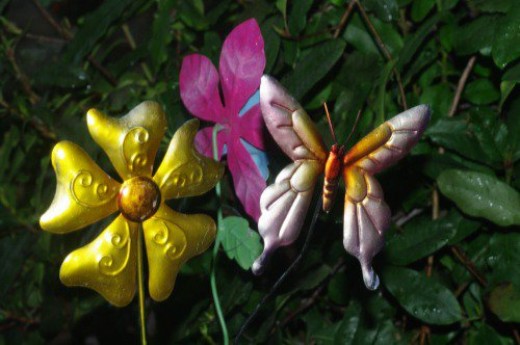
The entrance to the gardens leads to the gift shop, where you can gain admission, on one side, and a meeting room, usually with an art exhibit on the other. If you go through the gift shop and exit out the other door, you will be in a small garden with mostly flowering plants and a walkway, with a few cacti that bloom as well. Art is available for sale in the gift shop, and some of the art is outside. The photos is an example of a piece of outside art.
A small passageway between the building and the outside wall leads to another garden, which mostly contains flowering plants as well.
Continuing on around to the south of the building, you will see the tropical greenhouse. That is my favorite place, so I will talk about it next.
Garden Flowers - I'll tell you what they are...IF I know.
Click thumbnail to view full-size














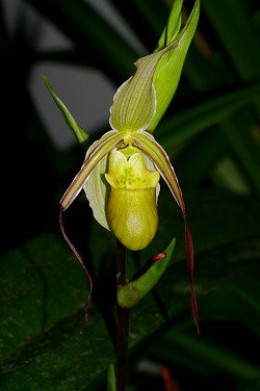
The Greenhouse
The atmosphere in the greenhouse is very different from that outside. Both places are generally warm to hot, but inside, it's humid as the dickens. The first time I went in there, the lens on my camera fogged up from the humidity and I had to wait several minutes for the fog to clear before I could take pictures.
The flower is a Slipper Orchid.
Flowers in the Greenhouse
Click thumbnail to view full-size




















Favorite flower
If you have a favorite flower, tell us what it is.
Do you have a favorite flower?
Greenhouse Inhabitants - other than butterflies
Click thumbnail to view full-size







Now for the Butterflies
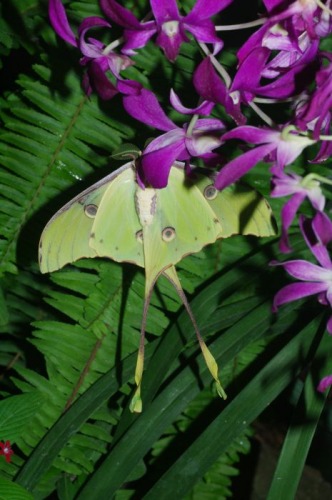
The gardens host butterflies from October through April. They acquire these butterflies from the tropical regions, including Mexico through South America, Australia, and Asia, including India in particular.
There is a very active group in India that studies the local butterflies. I am fortunate to get their group messages with photographs. I have personally only seen a tiny fraction of what they study.
I have photographed nearly 100 species, and I present just a few here. If you would like to see more, visit my article on Tropical Butterflies.
They usually have a moth or two, particularly an Atlas Moth. The moth in the picture is an African Moon Moth, similar to the Luna Moth.
A Few Butterflies - I like to call them "flying flowers"
Click thumbnail to view full-size












Zen Garden
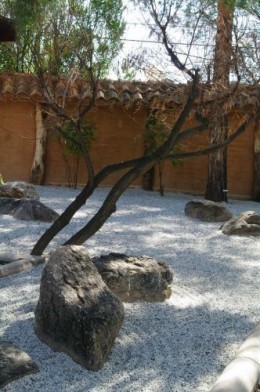
We are required to leave the greenhouse by 3 when there are butterflies in it, so I have another hour and a half to wander around before they close completely. If I go straight east, the usual direction, one of the first things I see is the Zen Garden. Here are a few pictures of it.


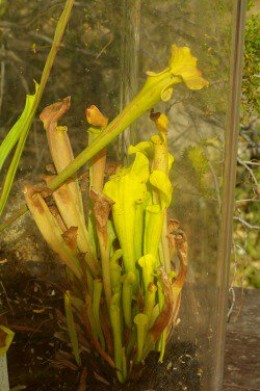
Weird Plants
Recently the Tucson Botanical Gardens has had an exhibit of really weird plants. They have a few growing outside in boxes, and inside a small building nearby, there are exhibits explaining some and showing dried versions, or photos or painted or sculpted examples. I didn't spend much time at this exhibit because I prefer to look at the real thing.
Here is one of the weird plants. I don't remember what it was, but it sure is weird!
Inhabitants
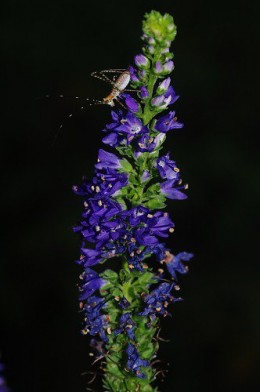
I rarely notice an insect on a flower at the time I take a picture, but occasionally I do. But I ALWAYS check the photos later to see if there were some visitors I didn't notice. That's what happened here. Notice the grasshopper on the upper left. I have no idea what species. But he's interesting!
Birds
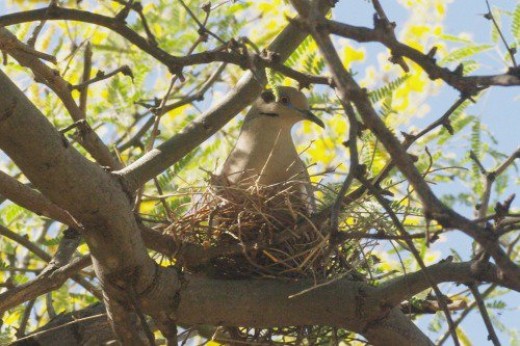
People who know me or who have read some of my other articles here are aware that I am an avid birdwatcher. However, I rarely pay much attention to birds when I am at Tucson Botanical Gardens, even though they have some fairly interesting ones. Here's why. I keep my macro lens on my camera while I am there. It's fixed at 90mm, which is far too much of a wide angle to get a bird in a tree somewhat distant, with any size image. By the time I would change my lens, if I chose to do so, the bird would be long gone. So I just concentrate on other things.
Last April, however, I was sitting on a bench resting, and I looked up, and lo and behold! within range of my macro lens, was a White-winged Dove sitting on a nest! Just earlier, I had seen a Northern Cardinal flying not that far away, but it was a fleeting glimpse, and there was no possibility of taking a picture.
Not long after that, I was with some birders. I don't remember where we were. We were looking at a Northern Cardinal, and she remarked that we don't have them in Tucson. And I said, well I saw one at Tucson Botanical Gardens just a few weeks ago. And she said, yeah, there. And I'm scratching my head, in my mind, of course, and wondering if the Tucson Botanical Gardens aren't in Tucson after all! (giggle)
Cactus and Succulents - and other species suitable for xeriscaping

Xeriscaping is a method of landscaping whereby the gardener chooses plants that require little water. It is practiced widely in southern Arizona.
Tucson Botanical Gardens has several areas devoted to the display of these plants. Here I will show you a few. I will also show you some desert wildflowers and other species that can be grown in a dry landscape.
The photo is Alluaudia procera, a plant of Madagascar. It appears to be similar to local Ocotillo, in its design. It would lose its leaves during drought.
Flowers for Xeriscaping - cactus, succulents, spring flowers, name given if known
Click thumbnail to view full-size




















Harrison's Rocks
Harrison Yocum had a fantastic rock collection. It consisted of the thousands of rocks he had gathered on his rock hunting trips, which he always shared with other people. The trips, not the rocks, I mean, but he did share the rocks to some extent as well, because he had two parties a year, and he always gave away door prizes. One of his favorites was what was called a bird's nest. He would start, usually, with a geode from the Day Ranch. The Day Ranch is where Sandra Day O'connor grew up, and is just across the border from Arizona, in New Mexico. I went there on rockhunting trips at least once. Into the geode he would place smaller stones, somewhat larger than pebbles, but small enough to be convincing size for eggs in the size nest he had.
Most of his rocks, the ones from his rockhunting trips, were in his yard. Most of those were piled up in large mountains of rock, taller than your height, probably more like your height plus vertical reach. In little niches on the surface, he planted little cacti and succulents and other little plants.
He also had an indoor collection, which wasn't large, but was made up of museum quality specimens in several cabinets.
Harrison willed his home and yard, and the rocks and collection of rare books on botany in several languages, to the Tucson Botanical Gardens. They were supposed to be preserved as a museum, but the board felt it couldn't afford to maintain it as a museum. Most of Harrison's rocks were moved to the current location and were used to dress the ground, or in an exhibit in a cabinet inside a small building (unfortunately, they don't always keep them on display, but I was able to catch them when they were, and I took some photos).
In this collection of photos, I show several specimens of copper ore of various kinds (malachite and azurite are both copper ores) which were collected in some of the copper mines around the state. I also show some specimens of quartz, which were collected in the Chiracahua Mountains in southeastern Arizona. These are all kept outside. In one photo showing up-standing rocks with cactus, I suspect the rocks are petrified wood. These were collected in northern Arizona. Although I went to the Chiracahuas more than once, I never made it on one of the rockhunting trips for petrified wood.
Rocks in the Tucson Botanical Gardens - Mostly from Harrison Yocum's collection
Click thumbnail to view full-size












Irises
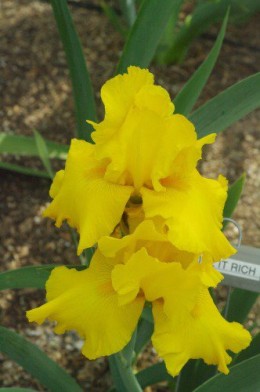
The last major display on the loop trail is the irises. This is a small garden that is maintained by the Tucson Area Iris Society. The sheer number of colors and patterns that have been achieved by breeding is mind-boggling. I am sure this is only a small sample of the varieties available.
These photos were taken this year and last.
I can't say I am fond of all the names chosen for the varieties, or that I think they are appropriate. For example, how about a flower with striking contrasting colors that is called "subtle"? But they are what they are.
This one is called "Strike It Rich".
Irises - Giving variety name if known
Click thumbnail to view full-size
























My Favorite Photo
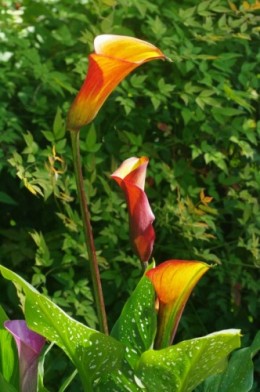
Of all the pictures of flowers I have taken at Tucson Botanical Gardens, I think this one is my favorite.
These are Calla Lilies. I never knew they came in any color but white, until a couple of years ago. Some of the other colors were probably the result of breeding, and they're beautiful! And I really like the simple form and curves.
I particularly like the composition of this photo. So I will end my tour with it, and bid you a safe journey in life.
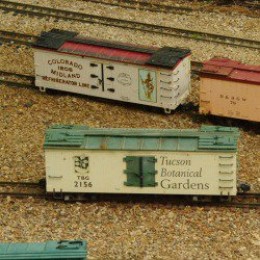
Thorneville Garden Railway
Model Train and Village
Right smack dab in the middle of the Botanical Gardens is a train layout! It was designed and built by Thorne Pierce and Gary Martin, along with the members of the Tucson Garden Railway Society. It's a cute little place, with a few touches of humor. On the left, in the back, are some rocks with a very small waterfall going down the front.
I have never spent a lot of time with model trains, though my husband has. From the little I know, I would GUESS that the trains are O gauge.
Part of the Village
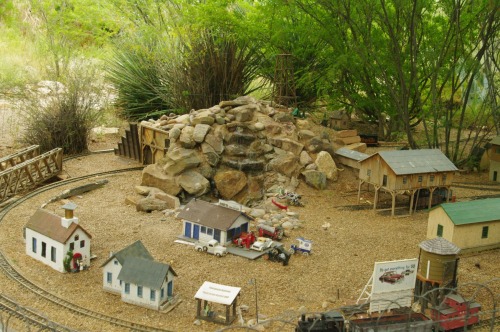
This is the view of the left hand end of the village. On the left, you see the church. There is a small traditional cemetery complete with picket fence behind it. In the back in the center is the pile of rocks with the waterfall. On the right, you see an engine house that will hold a couple of engines (maybe four, for all I know). In the foreground, lower right, is a billboard advertising the 1950 Chevrolet. This represents the eclectic nature of the items chosen, because there are cars of quite earlier vintage scattered here and there, together with a filling station with two red cylindrical pumps. I am sure you remember those, especially if you are my age.
Main Street - A Typical Wild West Town
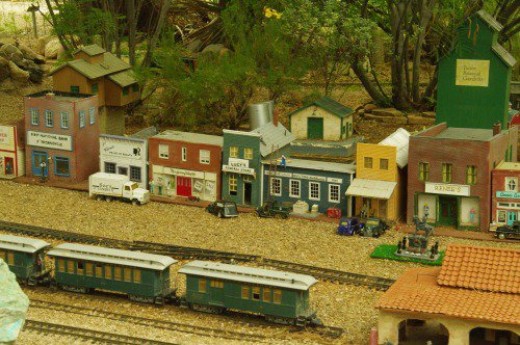
From left to right, there are: the barber shop, the bank, a beauty salon,. a Montgomery Ward, Lucy's general store, quilting supplies, what looks like just a house, Renee's (a dress shop?), and Connie's. In front of Renee's, there is a statue of a soldier on horseback.
The THING?
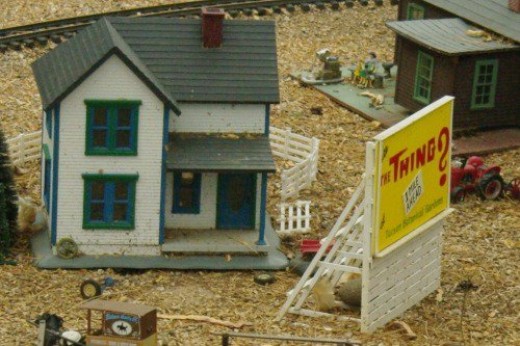
Who doesn't know about The THING? It's iconic around here. There are a few scattered trading-post type places along major highways in Arizona, which use these signs. There may be some in New Mexico, too, but I don't remember for sure.
I've never seen The THING. I have been in the store, but I didn't feel like paying an admission fee. My husband hasn't seen it, either. So it remains a mystery.
I like the touch of putting this sign in the middle of the village.
More Main Street
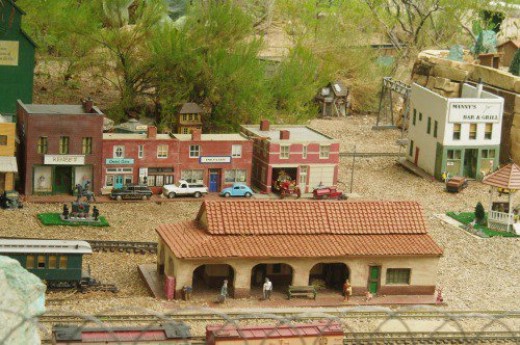
In this photo, you can see Connie's Curios, Emily's Cafe, the fire station, and Manny's Bar & Grill. In the foreground are the train station and a gazebo. You can see part of a Pullman car to the left (of which there are three).
You mean to tell me towns in Arizona really looked like this once? Actually, you can still see remnants of such towns in various places. The downtown area remains unchanged from eons ago.
Black Bear Lodge
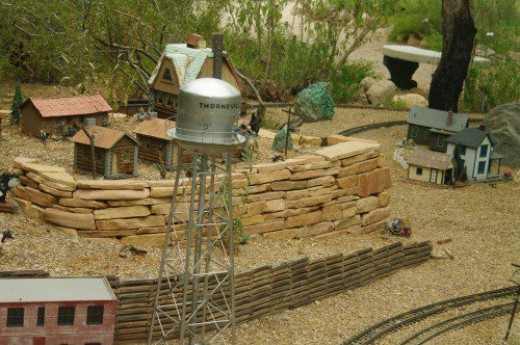
This is the Black Bear Lodge. There is actually a black bear, standing on his hind legs, just to the right of the water tower. You almost can't see him in this picture, but he's there.
I actually met a black bear, face to face. As bears go, they tend to be mild tempered, and the bear wasn't interested in doing anything more than satisfying his curiosity about me. Having done so, he ambled off.
Country View
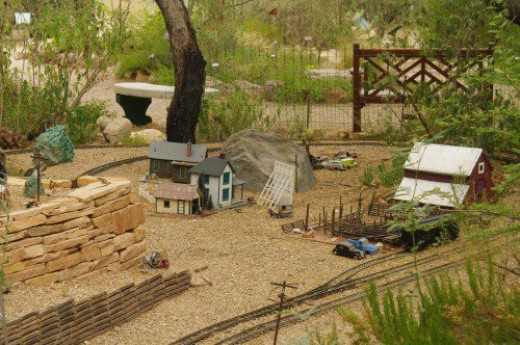
Here we have a couple of farm houses, a garage, and a barn with corral.
And tell me about your favorite flowers, if you want.

